Relativistic Particles and Commutator Algebras
四苯基乙烯衍生物的合成与生物成像研究

中文摘要四苯基乙烯衍生物的合成与生物成像研究生物成像已成为当今生物研究中的有力工具,因为它提供了一种独特的方法来可视化细胞的形态细节。
荧光成像是实时,非侵入性监测生物分子的最强大的生物成像技术之一。
在过去几十年中,荧光探针的发展已促进细胞生物学的重大进展。
各种荧光探针,如半导体量子点,荧光碳点,Ln离子掺杂纳米材料,光致发光硅纳米颗粒,金属纳米团簇,有机小分子和有机荧光纳米颗粒已被合成并广泛研究用于生物应用。
聚集诱导发光(AIE)材料由于其优异的光学性质在生物成像领域得到了广泛的研究。
本论文基于四苯基乙烯(TPE),合成了一系列具有聚集诱导发光性质的荧光材料,并利用这些材料制备的纳米粒子进行生物成像。
具体研究内容如下:1.以四苯基乙烯为核,通过选择电子供体(D)和受体(A)的适当组合来设计和合成AIE红光分子。
通过将二甲胺和氰基部分引入TPE中,合成了具有不同AIE特性的四种新的红光化合物1,2,3和4。
四种化合物在固态下的最高量子产率可达到40%。
该化合物可以容易地制造成均一稳定的荧光纳米粒子。
并且化合物1负载的Pluronic F127 纳米粒子的发射主峰位在650nm处,并且高荧光量子产率为15.2%。
化合物1和2的纳米粒子对A549肺癌细胞的生物学成像表明这些化合物是癌细胞的有效荧光探针。
2.基于四苯基乙烯,合成出一种新型有机荧光染料TPE-2NH2。
这种材料发绿光,在NO存在下能与其发生反应生成的产物发红光,因此这种材料具有检测NO的性质。
由于材料的疏水性,我们将此染料负载到二氧化硅介孔纳米粒子中,制备了的纳米粒子均一,稳定,具有120nm的平均粒径,良好的生物相容性,较高的灵敏度。
将此纳米粒子与MCF-7细胞共培养,在细胞质中发现红光信号。
因此,此探针在细胞内检测到NO,表现出良好的应用价值。
关键词:聚集诱导发光,四苯基乙烯,生物成像1AbstractSynthesis and Bioimaging Application of TetraphenyletheneDerivativesBiological imaging (bioimaging) has become a powerful tool in biological research today because it offers a unique approach to visualize the morphological details of cells. Fluorescence imaging is one of the most powerful bioimaging techniques for real-time, non-invasive monitoring of biomolecules of interest in their native environments with high spatial and temporal resolution, and is instrumental for revealing fundamental insights into the production, localization, trafficking, and biological roles of biomolecules in complex living systems. The development of fluorescent probes has facilitated the recent significant advances in cell biology and medical diagnostic imaging. Over the past few decades, a variety of fluorescent probes, such as semiconductor quantum dots, fluorescent carbon dots, Ln ion doped nanomaterials, photo-luminescent silicon nanoparticles, metallic nanoclusters, organic small molecules and organic fluorescent nanoparticles have been synthesized and extensively investigated for biological applications. Aggregation Induce Emision (AIE) materials have been extensively studied in the field of biomimetic imaging due to their excellent optical properties. In this paper, based on tetraphenyl ethylene (TPE), a series of fluorescent materials with aggregation induced luminescent properties were synthesized and biologically imaged using the nanoparticles prepared by these materials. The specific research contents are as follows:1. Organic fluorescent probes play an important role in modernbiomedical research, such as biological sensing and imaging. However, the development of organic fluorophores with efficient aggregate state emissions expanded to the red to near-infrared region is still challenging. Here, we present a series of highly efficient Far Red/Near-Infrared (FR/NIR)2fluorescent compounds with aggregation-induced emission (AIE) properties by attaching electron donor and accepter to tetraphenylethene (TPE) moieties through a simple synthesis method. These compounds exhibit the pronounced fluorescence enhancement in aggregate state, the red to near infrared emission, and facile fabrication into uniform compouds-loaded Pluronic F127 NPs. The emission maximum of the NPs fabricated by the self assembly method is in the range of 550nm-850nm and the highest fluorescent quantum yield is 15.2%. The biological imaging of NPs of compound 1 and 2 for A549 lung cancer cell indicates that these compounds are effective fluorescent probes for cancer cell with high specificity, high photostability and good fluorescence contrast.2. Based on tetraphenylethylene, a novel organic fluorescent dye TPE-2NH2 was synthesized. This material is green emision, it can be reacted and the product generated red emision the presence of NO, so this material has the nature of the detection of NO. Due to the hydrophobicity of the material, we loaded the dye into the silica mesoporous nanoparticles. The prepared nanoparticles were homogeneous and stable, with an average particle size of 120 nm, good biocompatibility and high sensitivity. The nanoparticles were co-cultured with MCF-7 cells, and red light was found in the cytoplasm. Therefore, this probe in the cell to detect NO, showing a good application value.Keywords:Aggregation-induced emission,Tetraphenylethene,bioimaging3目录第1章前言 (1)1.1引言 (1)1.2具有AIE性质的化合物 (3)1.3AIE小分子生物探针的制备及其应用 (16)1.4负载AIE化合物的荧光纳米粒子的制备及其应用 (28)1.5本论文设计思想和主要内容 (32)1.6参考文献 (33)第2章具有AIE性质的高效红光分子的合成及细胞成像 (45)2.1引言 (45)2.2实验部分 (46)2.3结果与讨论 (49)2.4本章小结 (57)2.5参考文献 (60)第3章基于AIE染料的RNS荧光探针的合成及性质研究 (62)3.1引言 (62)3.2实验部分 (63)3.3结果与讨论 (65)3.4本章小结 (70)3.5参考文献 (71)第4章结论 (74)作者简介 (83)致谢 (84)41第1章 前言1.1引言人们在分子水平上理解基本的发光过程已经取得了显著的成就。
On the negative effective mass density in acoustic metamaterials
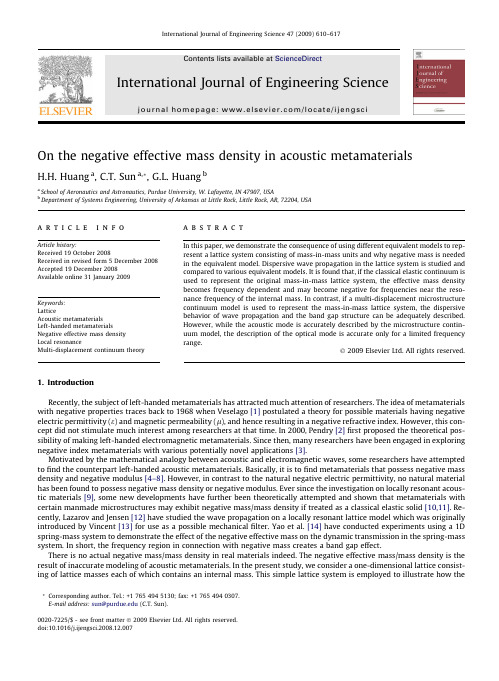
On the negative effective mass density in acoustic metamaterials
H.H. Huang a, C.T. Sun a,*,G.L. Huang b
a School of Aeronautics and Astronautics, Purdue University, W. Lafayette, IN 47907, USA b Department of Systems Engineering, University of Arkansas at Little Rock, Little Rock, AR, 72204, USA
* Corresponding author. Tel.: +1 765 494 5130; fax: +1 765 494 0307. E-mail address: sun@ (C.T. Sun).
TheKlein-Gordonequation:克莱因戈登方程
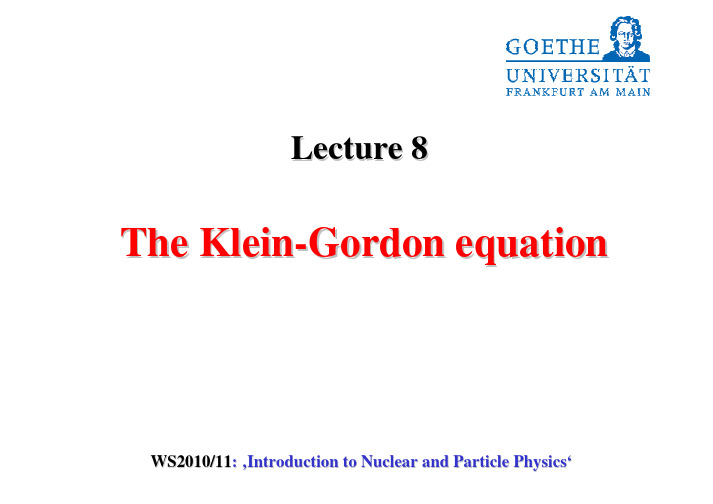
where the Lagrangian density satisfies the Euler-Lagrange equations of motions
(25)
such that the Euler-Lagrange equations of motion just give the Klein-Gordon equation (12) and its complex conjugate.
as the basic field equation of the scalar field.
The plane waves (10) are basic solutions and the field (9) is constructed by
a general superposition of the basic states.
Quantization
The challenge is to find operator solutions of the Klein-Gordon equation (12) which satisfy eq. (28). In analogy to the Lagrange density (24) , the hamiltonian is
Lecture 8
The Klein-Gordon equation
WS2010/11: ‚Introduction to Nuclear and Particle Physics‘
The bosons in field theory
Bosons with spin 0
scalar (or pseudo-scalar) meson fields
(23)
微波辐射相转移催化合成对甲苯基苄基醚
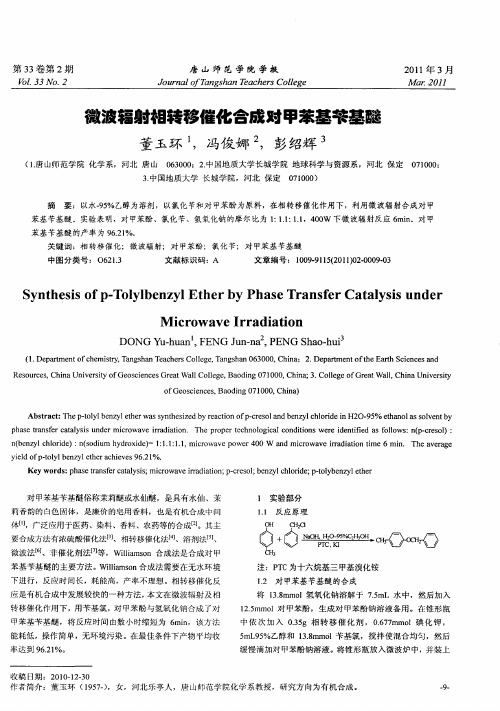
( . p rme t f h mir, a g h nT a h r l g , a g h n 0 3 0 , ia 2 De at e t fh at ce c s n 1 De at n c e s y T n s a e c esCol e T n s a 6 0 0 Chn : . p r n t eE rhS in e d o t e m o a Re o re , iaUnv ri f o ce c s etWal l g , o ig0 1 0 , hn ; . l g f e t l Chn ies s u c sChn iest o Ge sin e a lCol e Ba dn 7 0 0 C ia 3 Col eo Gra l y Gr e e Wa , iaUnv ri y t
董 玉环 ,冯俊 娜 2 ,彭绍辉 3
( . 山师 范 学 院 化 学 系 , 河 北 唐 山 0 3 0 ;2中 国地 质 大 学 长 城 学 院 地 球 科 学 与 资 源 系 , 河 北 保 定 1 唐 600 .
3中 国地 质 大 学 长 城 学 院 ,河 北 保 定 . 0 10 ) 7 00
第 3 卷 第 2期 3
). 3 N0 1 3 .2
唐 山 师 范 学 院 学 报
2 1 年 3月 01
M a. 1 r20 1
J un lfTn sa e c es ol e o r a a g h nTa h r l g o C e
微 波辐射相转移催化 合成对 甲苯基苄基醚
o e si c s B o ig0 0 , hn ) f o ce e, a dn 7 0 C ia G n 1 0
离散颗粒抑制热喷流红外辐射的大涡模拟
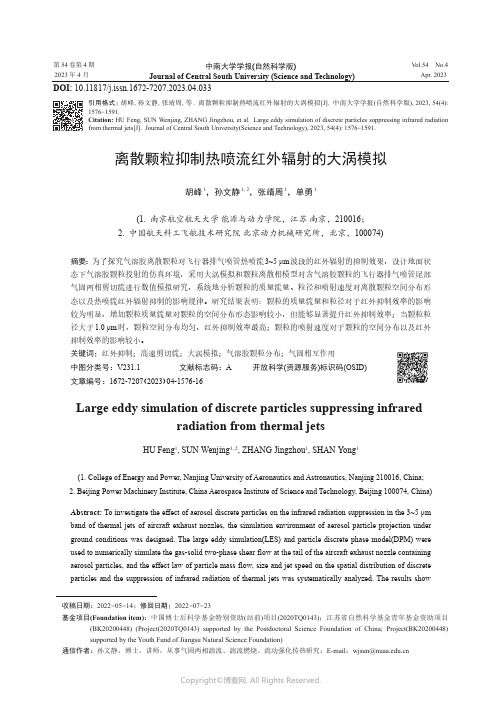
第 54 卷第 4 期2023 年 4 月中南大学学报(自然科学版)Journal of Central South University (Science and Technology)V ol.54 No.4Apr. 2023离散颗粒抑制热喷流红外辐射的大涡模拟胡峰1,孙文静1, 2,张靖周1,单勇1(1. 南京航空航天大学 能源与动力学院,江苏 南京,210016;2. 中国航天科工飞航技术研究院 北京动力机械研究所,北京,100074)摘要:为了探究气溶胶离散颗粒对飞行器排气喷管热喷流3~5 μm 波段的红外辐射的抑制效果,设计地面状态下气溶胶颗粒投射的仿真环境,采用大涡模拟和颗粒离散相模型对含气溶胶颗粒的飞行器排气喷管尾部气固两相剪切流进行数值模拟研究,系统地分析颗粒的质量流量、粒径和喷射速度对离散颗粒空间分布形态以及热喷流红外辐射抑制的影响规律。
研究结果表明:颗粒的质量流量和粒径对于红外抑制效率的影响较为明显,增加颗粒质量流量对颗粒的空间分布形态影响较小,但能够显著提升红外抑制效率;当颗粒粒径大于1.0 μm 时,颗粒空间分布均匀,红外抑制效率最高;颗粒的喷射速度对于颗粒的空间分布以及红外抑制效率的影响较小。
关键词:红外抑制;高速剪切流;大涡模拟;气溶胶颗粒分布;气固相互作用中图分类号:V231.1 文献标志码:A 开放科学(资源服务)标识码(OSID)文章编号:1672-7207(2023)04-1576-16Large eddy simulation of discrete particles suppressing infraredradiation from thermal jetsHU Feng 1, SUN Wenjing 1, 2, ZHANG Jingzhou 1, SHAN Yong 1(1. College of Energy and Power, Nanjing University of Aeronautics and Astronautics, Nanjing 210016, China;2. Beijing Power Machinery Institute, China Aerospace Institute of Science and Technology, Beijing 100074, China)Abstract: To investigate the effect of aerosol discrete particles on the infrared radiation suppression in the 3~5 μm band of thermal jets of aircraft exhaust nozzles, the simulation environment of aerosol particle projection under ground conditions was designed. The large eddy simulation(LES) and particle discrete phase model(DPM) were used to numerically simulate the gas-solid two-phase shear flow at the tail of the aircraft exhaust nozzle containing aerosol particles, and the effect law of particle mass flow, size and jet speed on the spatial distribution of discreteparticles and the suppression of infrared radiation of thermal jets was systematically analyzed. The results show收稿日期: 2022 −05 −14; 修回日期: 2022 −07 −23基金项目(Foundation item):中国博士后科学基金特别资助(站前)项目(2020TQ0143);江苏省自然科学基金青年基金资助项目(BK20200448) (Project(2020TQ0143) supported by the Postdoctoral Science Foundation of China; Project(BK20200448) supported by the Youth Fund of Jiangsu Natural Science Foundation)通信作者:孙文静,博士,讲师,从事气固两相湍流、湍流燃烧、流动强化传热研究;E-mail :**************.cnDOI: 10.11817/j.issn.1672-7207.2023.04.033引用格式: 胡峰, 孙文静, 张靖周, 等. 离散颗粒抑制热喷流红外辐射的大涡模拟[J]. 中南大学学报(自然科学版), 2023, 54(4): 1576−1591.Citation: HU Feng, SUN Wenjing, ZHANG Jingzhou, et al. Large eddy simulation of discrete particles suppressing infrared radiation from thermal jets[J]. Journal of Central South University(Science and Technology), 2023, 54(4): 1576−1591.第 4 期胡峰,等:离散颗粒抑制热喷流红外辐射的大涡模拟that the effect of particle mass flow and size on infrared radiation suppression rate is obvious. With the increase of particle mass flow, its effect on the spatial distribution of particles is small, but the infrared suppression efficiency is significantly improved. When the particle diameter is 1.0 μm, the particle space distribution is uniform and the highest infrared suppression rate is achieved. However, the particle injection speed has less effect on the spatial distribution of particles and infrared radiation suppression efficiency.Key words: infrared suppressing; high-speed shear flow; large eddy simulation; aerosol particle distribution; gas-solid interactions气溶胶红外隐身技术是一种主动型应急红外对抗技术,该技术利用附加的机载引气装置,将细微颗粒喷射在发动机热喷流周围形成气溶胶云,借此对排气喷管热内腔和热喷流的强红外辐射进行遮蔽和散射。
定量电子显微学方法与氧化钛纳米结构研究获国家自然科学二等奖
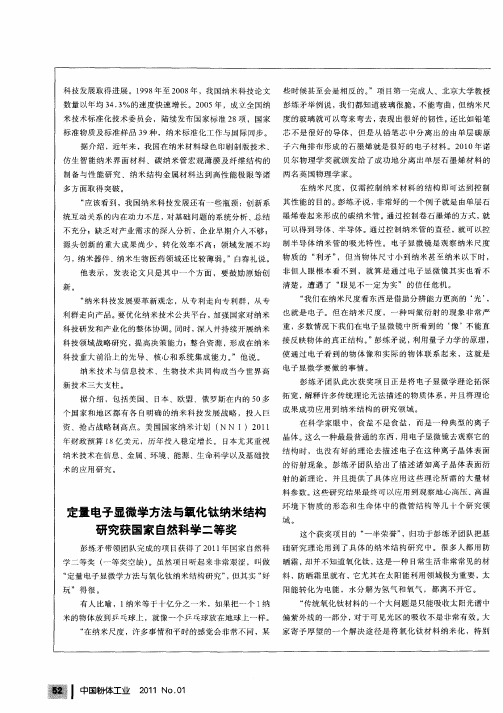
个 国家 和地 区都有 各 自明确 的纳 米 科技 发展 战略 ,投入 巨 成果 成功 应用 到纳米 结构 的研究 领域 。 在 科 学 家 眼 中 ,食 盐 不 是 食 盐 , 而 是 一 种 典 型 的 离 子 资 、抢 占战略制 高点 。美 国国家 纳米讨‘ ( 划 NN I)2 1 01 晶体 。 么一种 最最普 通的东 西 , 电子显微 镜去观 察它 的 这 用 年 财 政 预 算 l 美 元 ,历 年 投 入 稳 定 增 长 。 日本 尤 其 重 视 8亿 结构 时 ,也 没有 好的理 论去 描述 电子在 这种 离子 晶体 表面 纳 米技术在信 息 、金 属 、环境 、能源 、生命 科学 以及基础 技 的衍 射现 象 。彭 练矛 团 队给 出了描 述诸 如离 子 晶体表 面衍
仿 生智 能纳 米界 面材料 、碳纳 米管 宏观 薄膜 及纤 维结 构 的 贝 尔 物 理 学 奖 就 颁 发 给 了 成 功 地 分 离 出 单 层 石 墨 烯 材 料 的
制备与 性 能研究 、纳 米结 构金 属材 料达 到高 性 能极 限等诸 两 名 英 国 物 理 学 家 。
多 方面取得 突破 。
像 科 技 研 发 和 产 业 化 的 整 体 协 调 。同 时 , 入 并 持 续 开 展 纳 米 重 ,多 数 情 况 下 我 们 在 电 子 显 微 镜 中所 看 到 的 ‘ ’不 能 直 深 接反 映物体 的真正结 构 。 练矛 说 , 用量 子力学 的原理 , ”彭 利 科技领 域战 略研 究 ,提高 决策 能力 ;整合资 源 ,形成在纳 米
Evolution of the Fine Structure Constant Driven by Dark Matter and the Cosmological Constan

Physics Department, McGill University, 3600 University St, Montreal,Quebec H3A 2T8, Canada
D´ epartement de Physique, Universit´ e du Qu´ ebec ` a Montr´ eal C.P. 8888, Succ. Centre-Ville, Montr´ eal, Qu´ ebec, Canada, H3C 3P8
1
Introduction
Speculations that fundamental constants may vary in time and/or space go back to the original idea of Dirac [1]. Despite the reputable origin, this idea has not received much attention during the last fifty years for the two following reasons. First, there exist various sensitive experimental checks that coupling constants do not change (See, e.g. [2]). Second, for a long time there has not been any credible theoretical framework which would predict such changes. Our theoretical mindset, however, has changed since the advent of the string theory. One of the most interesting low-energy features of string theory is the possible presence of a massless scalar particle, the dilaton, whose vacuum expectation value defines the size of the effective gauge coupling constants. A change in the dilaton v.e.v. induces a change in the fine structure constant as well as the other gauge and Yukawa couplings. The stabilization of the dilaton v.e.v., which usually renders the dilaton massive, represents one of the fundamental challenges to be addressed before string theory can aspire to describe the observable world. Besides the dilaton, string theory often predicts the presence of other massless or nearly massless moduli fields, whose existence may influence particle physics and cosmology and may also change the effective values of the coupling constants as well. Independent of the framework of string theory, Bekenstein [3] formulated a dynamical model of “changing α”. The model consists of a massless scalar field which has a linear −1 φFµν F µν , where M∗ is an associated coupling to the F 2 term of the U (1) gauge field, M∗ mass scale and thought to be of order the Planck scale. A change in the background value of φ, can be interpreted as a change of the effective coupling constant. Bekenstein noticed that F 2 has a non-vanishing matrix element over protons and neutrons, of order (10−3 − 10−2 )mN . This matrix element acts as a source in the φ equation of motion and naturally leads to the cosmological evolution of the φ field driven by the baryon energy density. Thus, the change in φ translates into a change in α on a characteristic time scale comparable to the lifetime of the Universe or larger. However, the presence of a massless scalar field φ in the theory leads to the existence of an additional attractive force which does not respect Einstein’s weak universality principle. The extremely accurate checks of the latter [4] lead to a firm lower limit on M∗ , M∗ /MPl > 103 that confines possible changes of α to the range ∆α < 10−10 − 10−9 for 0 < z < 5 [3, 5]. This range is five orders of magnitude tighter than the change ∆α/α ≃ 10−5 indicated in the observations of quasar absorption spectra at z = 0.5 − 3.5 and recently reported by Webb et al. [6]. Given the potential fundamental importance of such a result, one should remain cautious until this result is independently verified. Nevertheless, leaving aside the issue regarding the reliability of the conclusions reached by Webb et al. [6], it is interesting to explore the possibility of constructing a dynamical model, including 1
多普勒展宽里德堡原子气体中的电磁诱导透明

多普勒展宽里德堡原子气体中的电磁诱导透明量子光学不断发展,光与物质相互作用所产生的量子相干效应一直是备受研究者关注的,如电磁诱导透明、绝热条件下粒子数转移、无反转激光等。
其中电磁诱导透明现象被应用到许多领域中:粒子数的相干俘获、相干增强克尔非线性、静止光等等。
随着对电磁诱导透明现象的深入探究,研究者发现电磁诱导透明的实现体系也在不断被扩展。
近年来,具有长程偶极-偶极相互作用的里德堡原子体系成为了研究者关注的焦点之一。
里德堡原子由于其较大的主量子数,具有异于普通原子的特殊性质。
研究者将电磁诱导透明现象拓展到里德堡原子系综中,里德堡-电磁诱导透明现象为我们提供了更好的机会来实现对光的有效控制。
然而实现电磁诱导透明的体系多数为超冷的里德堡原子系综,主要原因是多数研究工作为了理论计算的简便,忽略了温度的影响,但是系统中残余温度所引起的多普勒效应实际上是不可忽略的。
本论文希望能够修正原有的计算方法,在一定温度下(~mK),研究多普勒展宽对里德堡原子系综稳态光学响应的影响。
在已有的相关工作中,研究者已经介绍了在电磁诱导透明机制下普通原子系综中多普勒展宽的计算方法。
而且超级原子模型作为处理里德堡原子系综中电磁诱导透明的有效方法之一,我们希望结合两种计算方法,进一步提高原有理论模型的精确性。
本论文采用的是三能级梯形原子结构,在超越弱场近似的超级原子模型中加入多普勒效应的影响。
计算得到有限温度下里德堡原子系综的稳态光学响应,接下来我们尝试改变系统的温度,探测光场和耦合光场的传播方向,原子群速度大小及方向等因素,探究多普勒展宽的作用效果。
本论文主要以探测场的透射函数和探测光子的二阶关联函数为例讨论多普勒效应的影响,结果表明系综中残余的热效应会削弱探测光子的非经典统计特性。
而且探测场与耦合场同向传播时,多普勒效应对系统的相干特性有破坏作用,而反向传播时能够部分消除多普勒效应。
2007自然杂志石墨烯诺贝尔得奖者文章
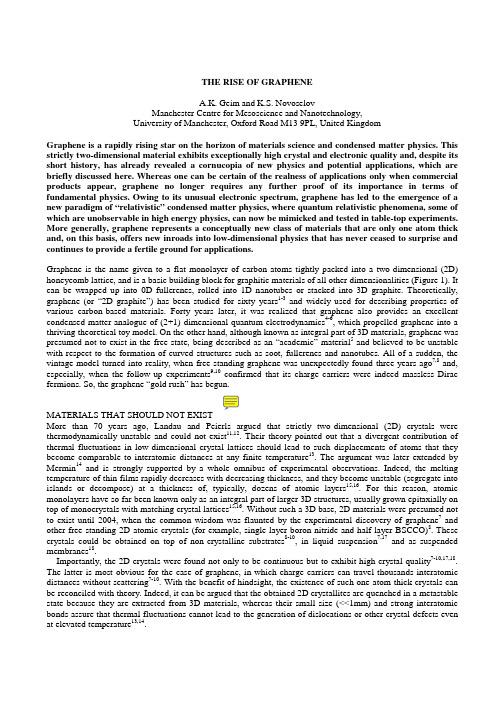
THE RISE OF GRAPHENEA.K. Geim and K.S. NovoselovManchester Centre for Mesoscience and Nanotechnology,University of Manchester, Oxford Road M13 9PL, United KingdomGraphene is a rapidly rising star on the horizon of materials science and condensed matter physics. This strictly two-dimensional material exhibits exceptionally high crystal and electronic quality and, despite its short history, has already revealed a cornucopia of new physics and potential applications, which are briefly discussed here. Whereas one can be certain of the realness of applications only when commercial products appear, graphene no longer requires any further proof of its importance in terms of fundamental physics. Owing to its unusual electronic spectrum, graphene has led to the emergence of a new paradigm of “relativistic” condensed matter physics, where quantum relativistic phenomena, some of which are unobservable in high energy physics, can now be mimicked and tested in table-top experiments. More generally, graphene represents a conceptually new class of materials that are only one atom thick and, on this basis, offers new inroads into low-dimensional physics that has never ceased to surprise and continues to provide a fertile ground for applications.Graphene is the name given to a flat monolayer of carbon atoms tightly packed into a two-dimensional (2D) honeycomb lattice, and is a basic building block for graphitic materials of all other dimensionalities (Figure 1). It can be wrapped up into 0D fullerenes, rolled into 1D nanotubes or stacked into 3D graphite. Theoretically, graphene (or “2D graphite”) has been studied for sixty years1-3 and widely used for describing properties of various carbon-based materials. Forty years later, it was realized that graphene also provides an excellent condensed-matter analogue of (2+1)-dimensional quantum electrodynamics4-6, which propelled graphene into a thriving theoretical toy model. On the other hand, although known as integral part of 3D materials, graphene was presumed not to exist in the free state, being described as an “academic” material5 and believed to be unstable with respect to the formation of curved structures such as soot, fullerenes and nanotubes. All of a sudden, the vintage model turned into reality, when free-standing graphene was unexpectedly found three years ago7,8 and, especially, when the follow-up experiments9,10 confirmed that its charge carriers were indeed massless Dirac fermions. So, the graphene “gold rush” has begun.MATERIALS THAT SHOULD NOT EXISTMore than 70 years ago, Landau and Peierls argued that strictly two-dimensional (2D) crystals were thermodynamically unstable and could not exist11,12. Their theory pointed out that a divergent contribution of thermal fluctuations in low-dimensional crystal lattices should lead to such displacements of atoms that they become comparable to interatomic distances at any finite temperature13. The argument was later extended by Mermin14 and is strongly supported by a whole omnibus of experimental observations. Indeed, the melting temperature of thin films rapidly decreases with decreasing thickness, and they become unstable (segregate into islands or decompose) at a thickness of, typically, dozens of atomic layers15,16. For this reason, atomic monolayers have so far been known only as an integral part of larger 3D structures, usually grown epitaxially on top of monocrystals with matching crystal lattices15,16. Without such a 3D base, 2D materials were presumed not to exist until 2004, when the common wisdom was flaunted by the experimental discovery of graphene7 and other free-standing 2D atomic crystals (for example, single-layer boron nitride and half-layer BSCCO)8. These crystals could be obtained on top of non-crystalline substrates8-10, in liquid suspension7,17 and as suspended membranes18.Importantly, the 2D crystals were found not only to be continuous but to exhibit high crystal quality7-10,17,18. The latter is most obvious for the case of graphene, in which charge carriers can travel thousands interatomic distances without scattering7-10. With the benefit of hindsight, the existence of such one-atom-thick crystals can be reconciled with theory. Indeed, it can be argued that the obtained 2D crystallites are quenched in a metastable state because they are extracted from 3D materials, whereas their small size (<<1mm) and strong interatomic bonds assure that thermal fluctuations cannot lead to the generation of dislocations or other crystal defects even at elevated temperature13,14.Figure 1. Mother of all graphitic forms. Graphene is a 2D building material for carbon materials of all other dimensionalities. It can be wrapped up into 0D buckyballs, rolled into 1D nanotubes or stacked into 3D graphite.A complementary viewpoint is that the extracted 2D crystals become intrinsically stable by gentle crumpling in the third dimension on a lateral scale of ≈10nm 18,19. Such 3D warping observed experimentally 18 leads to a gain in elastic energy but suppresses thermal vibrations (anomalously large in 2D), which above a certain temperature can minimize the total free energy 19.BRIEF HISTORY OF GRAPHENEBefore reviewing the earlier work on graphene, it is useful to define what 2D crystals are. Obviously, a single atomic plane is a 2D crystal, whereas 100 layers should be considered as a thin film of a 3D material. But how many layers are needed to make a 3D structure? For the case of graphene, the situation has recently become reasonably clear. It was shown that the electronic structure rapidly evolves with the number of layers, approaching the 3D limit of graphite already at 10 layers 20. Moreover, only graphene and, to a good approximation, its bilayer have simple electronic spectra: they are both zero-gap semiconductors (can also be referred to as zero-overlap semimetals) with one type of electrons and one type of holes. For 3 and more layers, the spectra become increasingly complicated: Several charge carriers appear 7,21, and the conduction and valence bands start notably overlapping 7,20. This allows one to distinguish between single-, double- and few- (3 to <10) layer graphene as three different types of 2D crystals (“graphenes”). Thicker structures should be considered, to all intents and purposes, as thin films of graphite. From the experimental point of view, such a definition is also sensible. The screening length in graphite is only ≈5Å (that is, less than 2 layers in thickness)21 and, hence, one must differentiate between the surface and the bulk even for films as thin as 5 layers.21,22Earlier attempts to isolate graphene concentrated on chemical exfoliation. To this end, bulk graphite was first intercalated (to stage I)23so that graphene planes became separated by layers of intervening atoms or molecules.This usually resulted in new 3D materials23. However, in certain cases, large molecules could be inserted between atomic planes, providing greater separation such that the resulting compounds could be considered as isolated graphene layers embedded in a 3D matrix. Furthermore, one can often get rid of intercalating molecules in a chemical reaction to obtain a sludge consisting of restacked and scrolled graphene sheets24-26. Because of its uncontrollable character, graphitic sludge has so far attracted only limited interest.There have also been a small number of attempts to grow graphene. The same approach as generally used for growth of carbon nanotubes so far allowed graphite films only thicker than ≈100 layers27. On the other hand, single- and few-layer graphene have been grown epitaxially by chemical vapour deposition of hydrocarbons on metal substrates28,29 and by thermal decomposition of SiC30-34. Such films were studied by surface science techniques, and their quality and continuity remained unknown. Only lately, few-layer graphene obtained on SiC was characterized with respect to its electronic properties, revealing high-mobility charge carriers32,33. Epitaxial growth of graphene offers probably the only viable route towards electronic applications and, with so much at stake, a rapid progress in this direction is expected. The approach that seems promising but has not been attempted yet is the use of the previously demonstrated epitaxy on catalytic surfaces28,29 (such as Ni or Pt) followed by the deposition of an insulating support on top of graphene and chemical removal of the primary metallic substrate.THE ART OF GRAPHITE DRAWINGIn the absence of quality graphene wafers, most experimental groups are currently using samples obtained by micromechanical cleavage of bulk graphite, the same technique that allowed the isolation of graphene for the first time7,8. After fine-tuning, the technique8 now provides high-quality graphene crystallites up to 100 µm in size, which is sufficient for most research purposes (see Figure 2). Superficially, the technique looks as nothing more sophisticated than drawing by a piece of graphite8 or its repeated peeling with adhesive tape7 until the thinnest flakes are found. A similar approach was tried by other groups (earlier35 and independently22,36) but only graphite flakes 20 to 100 layers thick were found. The problem is that graphene crystallites left on a substrate are extremely rare and hidden in a “haystack” of thousands thick (graphite) flakes. So, even if one were deliberately searching for graphene by using modern techniques for studying atomically thin materials, it would be impossible to find those several micron-size crystallites dispersed over, typically, a 1-cm2 area. For example, scanning-probe microscopy has too low throughput to search for graphene, whereas scanning electron microscopy is unsuitable because of the absence of clear signatures for the number of atomic layers.The critical ingredient for success was the observation7,8 that graphene becomes visible in an optical microscope if placed on top of a Si wafer with a carefully chosen thickness of SiO2, owing to a feeble interference-like contrast with respect to an empty wafer. If not for this simple yet effective way to scan substrates in search of graphene crystallites, they would probably remain undiscovered today. Indeed, even knowing the exact recipe7,8, it requires special care and perseverance to find graphene. For example, only a 5% difference in SiO2 thickness (315 nm instead of the current standard of 300 nm) can make single-layer graphene completely invisible. Careful selection of the initial graphite material (so that it has largest possible grains) and the use of freshly -cleaved and -cleaned surfaces of graphite and SiO2 can also make all the difference. Note that graphene was recently37,38 found to have a clear signature in Raman microscopy, which makes this technique useful for quick thickness inspection, even though potential crystallites still have to be first hunted for in an optical microscope.Similar stories could be told about other 2D crystals (particularly, dichalcogenides monolayers) where many attempts were made to split these strongly layered materials into individual planes39,40. However, the crucial step of isolating monolayers to assess their properties individually was never achieved. Now, by using the same approach as demonstrated for graphene, it is possible to investigate potentially hundreds of different 2D crystals8 in search of new phenomena and applications.FERMIONS GO BALLISTICAlthough there is a whole class of new 2D materials, all experimental and theoretical efforts have so far focused on graphene, somehow ignoring the existence of other 2D crystals. It remains to be seen whether this bias is justified but the primary reason for it is clear: It is the exceptional electronic quality exhibited by the isolated graphene crystallites7-10. From experience, people know that high-quality samples always yield new physics, and this understanding has played a major role in focusing attention on graphene.Figure 2. One-atom-thick single crystals: the thinnest material you will ever see. a, Graphene visualized by atomic-force microscopy (adapted from ref. 8). The folded region exhibiting a relative height of ≈4Å clearly indicates that it is a single layer. b, A graphene sheet freely suspended on a micron-size metallic scaffold. The transmission-electron-microscopy image is adapted from ref. 18. c, scanning-electron micrograph of a relatively large graphene crystal, which shows that most of the crystal’s faces are zigzag and armchair edges as indicated by blue and red lines and illustrated in the inset (T.J. Booth, K.S.N, P. Blake & A.K.G. unpublished). 1D transport along zigzag edges and edge-related magnetism are expected to attract significant attention.Graphene’s quality clearly reveals itself in a pronounced ambipolar electric field effect (Fig. 3a) such that charge carriers can be tuned continuously between electrons and holes in concentrations n as high as 1013cm-2 and their mobilities µ can exceed 15,000 cm2/Vs even under ambient conditions7-10. Moreover, the observed mobilities weakly depend on temperature T, which means that µ at 300K is still limited by impurity scattering and, therefore, can be improved significantly, perhaps, even up to ≈100,000 cm2/Vs. Although some semiconductors exhibit room-temperature µ as high as ≈77,000 cm2/Vs (namely, InSb), those values are quoted for undoped bulk semiconductors. In graphene, µ remains high even at high n (>1012cm-2) in both electrically- and chemically- doped devices41, which translates into ballistic transport on submicron scale (up to ≈0.3 µm at 300K). A further indication of the system’s extreme electronic quality is the quantum Hall effect (QHE) that can be observed in graphene even at room temperature (Fig. 3b), extending the previous temperature range for the QHE by a factor of 10.An equally important reason for the interest in graphene is a unique nature of its charge carriers. In condensed matter physics, the Schrödinger equation rules the world, usually being quite sufficient to describe electronic properties of materials. Graphene is an exception: Its charge carriers mimic relativistic particles and are easier and more natural to describe starting with the Dirac equation rather than the Schrödinger equation4-6,42-47. Although there is nothing particularly relativistic about electrons moving around carbon atoms, their interaction with a periodic potential of graphene’s honeycomb lattice gives rise to new quasiparticles that at low energies EFigure 3. Ballistic electron transport in graphene. a , Ambipolar electric field effect in single-layer graphene. The insets show its conical low-energy spectrum E (k ), indicating changes in the position of the Fermi energy E F with changing gate voltage V g . Positive (negative) V g induce electrons (holes) in concentrations n =αV g where the coefficient α ≈7.2⋅1010cm -2/V for field-effect devices with a 300 nm SiO 2 layer used as a dielectric 7-9. The rapid decrease in resistivity ρwith adding charge carriers indicates their high mobility (in this case, µ ≈5,000cm 2/Vs and does not noticeably change with temperature up to 300K). b , Room-temperature quantum Hall effect (K.S.N., Z. Jiang, Y. Zhang, S.V. Morozov, H.L. Stormer, U. Zeitler,J.C. Maan, G.S. Boebinger, P. Kim & A.K.G. Science 2007, in the press). Because quasiparticles in graphene are massless and also exhibit little scattering even under ambient conditions, the QHE survives up to room T . Shown in red is the Hall conductivity σxy that exhibits clear plateaux at 2e 2/h for both electrons and holes. The longitudinal conductivity ρxx (blue) reaches zero at the same gate voltages. The inset illustrates the quantized spectrum of graphene where the largest cyclotron gap is described by δE (K)≈420⋅B (T). are accurately described by the (2+1)-dimensionalDirac equation with an effective speed of lightv F ≈106m/s. These quasiparticles, called masslessDirac fermions, can be seen as electrons that losttheir rest mass m 0 or as neutrinos that acquired theelectron charge e . The relativistic-like descriptionof electron waves on honeycomb lattices has beenknown theoretically for many years, never failingto attract attention, and the experimental discoveryof graphene now provides a way to probe quantumelectrodynamics (QED) phenomena by measuringgraphene’s electronic properties.QED IN A PENCIL TRACEFrom the point of view of its electronic properties,graphene is a zero-gap semiconductor, in whichlow-E quasiparticles within each valley canformally be described by the Dirac-likeHamiltoniank v ik k ik k v H F y x y x F r r h h ⋅=⎟⎟⎠⎞⎜⎜⎝⎛+−=σ00ˆwhere k r is the quasiparticle momentum, σr the2D Pauli matrix and the k -independent Fermivelocity v F plays the role of the speed of light. TheDirac equation is a direct consequence ofgraphene’s crystal symmetry. Its honeycomblattice is made up of two equivalent carbonsublattices A and B , and cosine-like energy bandsassociated with the sublattices intersect at zero Enear the edges of the Brillouin zone, giving rise toconical sections of the energy spectrum for |E | <1eV (Fig. 3).We emphasize that the linear spectrumk v E F h = is not the only essential feature of the band structure. Indeed, electronic states near zeroE (where the bands intersect) are composed ofstates belonging to the different sublattices, andtheir relative contributions in quasiparticles’make-up have to be taken into account by, forexample, using two-component wavefunctions(spinors). This requires an index to indicatesublattices A and B , which is similar to the spinindex (up and down) in QED and, therefore, isreferred to as pseudospin. Accordingly, in theformal description of graphene’s quasiparticles bythe Dirac-like Hamiltonian above, σr refers topseudospin rather than the real spin of electrons(the latter must be described by additional terms inthe Hamiltonian). Importantly, QED-specificphenomena are often inversely proportional to thespeed of light c and, therefore, enhanced ingraphene by a factor c /v F ≈300. In particular, thisρ(kΩ)n(1012 cm-2)σ(4e2/h)277321−21+23255-82-2-4-664Vg(V)σ2EDEdecEFigure 4. Chiral quantum Hall effects.a, The hallmark of massless Dirac fermions is QHE plateaux in σxy at half integers of 4e2/h (adapted from ref. 9). b, Anomalous QHE for massive Dirac fermions in bilayer graphene is more subtle (red curve55): σxy exhibits the standard QHE sequence with plateaux at all integer N of 4e2/h except for N=0. The missing plateau is indicated by the red arrow. The zero-N plateau can be recovered after chemical doping, which shifts the neutrality point to high V g so that an asymmetry gap (≈0.1eV in this case) is opened by the electric field effect (green curve; adapted from ref.59). c-e, Different types of Landau quantization in graphene. The sequence of Landau levels in the density of states D isdescribed by NEN∝ for massless Dirac fermions in single-layer graphene (c) and by )1(−∝NNENfor massive Dirac fermions in bilayer graphene (d). The standard LL sequence )(21+∝NENis expected to recover if an electronic gap is opened in the bilayer (e).means that pseudospin-related effects should generally dominate those due to the real spin.By analogy with QED, one can also introduce a quantity called chirality6 that is formally a projection of σr on the direction of motion kr and is positive (negative) for electrons (holes). In essence, chirality in graphene signifies the fact that k electron and -k hole states are intricately connected by originating from the same carbon sublattices. The concepts of chirality and pseudospin are important because many electronic processes in graphene can be understood as due to conservation of these quantities.6,42-47It is interesting to note that in some narrow-gap 3D semiconductors, the gap can be closed by compositional changes or by applying high pressure. Generally, zero gap does not necessitate Dirac fermions (that imply conjugated electron and hole states) but, in some cases, they may appear5. The difficulties of tuning the gap to zero, while keeping carrier mobilities high, the lack of possibility to control electronic properties of 3D materials by the electric field effect and, generally, less pronounced quantum effects in 3D limited studies of such semiconductors mostly to measuring the concentration dependence of their effective masses m (for a review, see ref. 48). It is tempting to have a fresh look at zero-gap bulk semiconductors, especially because Dirac fermions were recently reported even in such a well-studied (small-overlap) 3D material as graphite.49,50CHIRAL QUANTUM HALL EFFECTSAt this early stage, the main experimental efforts have been focused on electronic properties of graphene, trying to understand the consequences of its QED-like spectrum. Among the most spectacular phenomena reported so far, there are two new (“chiral”) quantum Hall effects, minimum quantum conductivity in the limit of vanishing concentrations of charge carriers and strong suppression of quantum interference effects.Figure 4 shows three types of the QHE behaviour observed in graphene. The first one is a relativistic analogue of the integer QHE and characteristic to single-layer graphene9,10. It shows up as an uninterrupted ladder of equidistant steps in Hall conductivity σxy which persists through the neutrality (Dirac) point, where charge carriers change from electrons to holes (Fig. 4a). The sequence is shifted with respect to the standard QHE sequence by ½, so that σxy= ±4e2/h(N + ½) where N is the Landau level (LL) index and factor 4 appears due to double valley and double spin degeneracy. This QHE has been dubbed “half-integer” to reflect both the shift and the fact that, although it is not a new fractional QHE, it is not the standard integer QHE either. The unusual sequence is now well understood as arising due to the QED-like quantization of graphene’s electronic spectrumin magnetic field B , which is described 44,51-53 by BN e v E F N h 2±= where sign ± refers to electrons and holes. The existence of a quantized level at zero E , which is shared by electrons and holes (Fig. 4c), is essentially everything one needs to know to explain the anomalous QHE sequence.51-55 An alternative explanation for the half-integer QHE is to invoke the coupling between pseudospin and orbital motion, which gives rise to a geometrical phase of π accumulated along cyclotron trajectories and often referred to as Berry’s phase.9,10,56 The additional phase leads to a π-shift in the phase of quantum oscillations and, in the QHE limit, to a half-step shift. Bilayer graphene exhibits an equally anomalous QHE (Fig 4b)55. Experimentally, it shows up less spectacular: One measures the standard sequence of Hall plateaux σxy = ±N 4e 2/h but the very first plateau at N =0 is missing, which also implies that bilayer graphene remains metallic at the neutrality point.55 The origin of this anomaly lies in a rather bizarre nature of quasiparticles in bilayer graphene, which are described 57 by⎟⎟⎠⎞⎜⎜⎝⎛+−−=0)()(02ˆ222y x y x ik k ik k m H h This Hamiltonian combines the off-diagonal structure, similar to the Dirac equation, with Schrödinger-like terms m p2ˆ2. The resulting quasiparticles are chiral, similar to massless Dirac fermions, but have a finite mass m ≈0.05m 0. Such massive chiral particles would be an oxymoron in relativistic quantum theory. The Landau quantization of “massive Dirac fermions” is given 57 by )1(−±=N N E c N ωh with two degenerate levels N =0 and 1 at zero E (c ω is the cyclotron frequency). This additional degeneracy leads to the missing zero-E plateau and the double-height step in Fig. 4b. There is also a pseudospin associated with massive Dirac fermions, and its orbital rotation leads to a geometrical phase of 2π. This phase is indistinguishable from zero in the quasiclassical limit (N >>1) but reveals itself in the double degeneracy of the zero-E LL (Fig. 4d).55It is interesting that the “standard” QHE with all the plateaux present can be recovered in bilayer graphene by the electric field effect (Fig. 4b). Indeed, gate voltage not only changes n but simultaneously induces an asymmetry between the two graphene layers, which results in a semiconducting gap 58,59. The electric-field-induced gap eliminates the additional degeneracy of the zero-E LL and leads to the uninterrupted QHE sequence by splitting the double step into two (Fig. 4e)58,59. However, to observe this splitting in the QHE measurements, one needs to probe the region near the neutrality point at finite V g , which can be achieved by additional chemical doping 59. Note that bilayer graphene is the only known material in which the electronic band structure changes significantly by the electric field effect and the semiconducting gap ∆E can be tuned continuously from zero to ≈0.3eV if SiO 2 is used as a dielectric.CONDUCTIVITY “WITHOUT” CHARGE CARRIERSAnother important observation is that graphene’s zero-field conductivity σ does not disappear in the limit of vanishing n but instead exhibits values close to the conductivity quantum e 2/h per carrier type 9. Figure 5 shows the lowest conductivity σmin measured near the neutrality point for nearly 50 single-layer devices. For all other known materials, such a low conductivity unavoidably leads to a metal-insulator transition at low T but no sign of the transition has been observed in graphene down to liquid-helium T . Moreover, although it is the persistence of the metallic state with σ of the order of e 2/h that is most exceptional and counterintuitive, a relatively small spread of the observed conductivity values (see Fig. 5) also allows one to speculate about the quantization of σmin . We emphasize that it is the resistivity (conductivity) that is quantized in graphene, in contrast to the resistance (conductance) quantization known in many other transport phenomena.Minimum quantum conductivity has been predicted for Dirac fermions by a number of theories 5,44,45,47,60-64. Some of them rely on a vanishing density of states at zero E for the linear 2D spectrum. However, comparison between the experimental behaviour of massless and massive Dirac fermions in graphene and its bilayer allows one to distinguish between chirality- and masslessness- related effects. To this end, bilayer graphene also exhibits a minimum conductivity of the order of e 2/h per carrier type,55,65 which indicates that it is chirality, rather than the linear spectrum, that is more important. Most theories suggest σmin =4e 2/h π, which is of about π times smaller than the typical values observed experimentally. One can see in Fig. 5 that the experimental data do not approach this theoretical value and mostly cluster around σmin =4e 2/h (except for one low-µ sample that is rather unusual by also exhibiting 100%-normal weak localization behaviour at high n ; see below). This disagreement has become known as “the mystery of a missing pie”, and it remains unclear whether it is due toσm i n (4e 2/h )11/µ(cm 2/Vs)012,0004,0008,0000Figure 5. Minimum conductivity of graphene.Independent of their carrier mobility µ, different graphene devices exhibited approximately the same conductivity at the neutrality point (open circles) with most data clusteringaround ≈4e 2/h indicated for clarity by the dashed line (A.K.G. & K.S.N. unpublished; includes the published datapoints from ref. 9). The high-conductivity tail is attributed to macroscopic inhomogeneity: by improving samples’ homogeneity, σmin generally decreases, moving closer to ≈4e 2/h . The green arrow and symbols show one of the devices that initially exhibited an anomalously large value of σmin but after thermal annealing at 400K its σmin moved closer to the rest of the statistical ensemble. Most of thedata are taken in the bend resistance geometry where themacroscopic inhomogeneity plays the least role.theoretical approximations about electron scatteringin graphene or because the experiments probed onlya limited range of possible sample parameters (e.g., length-to-width ratios 47). To this end, note that close to the neutrality point (n ≤1011cm -2) graphene islikely to conduct as a random network of electronand hole puddles (A.K.G. & K.S.N . unpublished).Such microscopic inhomogeneity is probablyinherent to graphene (because of graphene sheet’swarping/rippling)18,66 but so far has not been taken into account by theory. Furthermore, macroscopicinhomogeneity (on the scale larger than the meanfree path l ) also plays an important role in measurements of σmin . The latter inhomogeneity canexplain a high-σ tail in the data scatter in Fig. 5 by the fact that σ reached its lowest values at slightly different V g in different parts of a sample, whichyields effectively higher values of experimentally measured σmin .WEAK LOCALIZATION IN SHORT SUPPLYAt low temperatures, all metallic systems with high resistivity should inevitably exhibit large quantum-interference (localization) magnetoresistance,eventually leading to the metal-insulator transition at σ ≈e 2/h . Until now, such behaviour has been absolutely universal but it was found missing in graphene. Even near the neutrality point, no significant low-field (B <1T) magnetoresistance has been observed down to liquid-helium temperatures 66 and, although sub-100 nm Hall crosses did exhibit giant resistance fluctuations (S.V. Morozov, K.S.N., A.K.G. et al , unpublished), those could be attributed to changes in the distribution of electron and holepuddles and size quantization. It remains to be seen whether localization effects at the Dirac point recover at lower T , as the phase-breaking length becomes increasingly longer,67 or the observed behaviour indicates a “marginal Fermi liquid”68,43, in which the phase-breaking length goes to zero with decreasing E . Further experimental studies are much needed in this regime but it is difficult to probe because of microscopic inhomogeneity.Away from the Dirac point (where graphene becomes a good metal), the situation has recently become reasonably clear. Universal conductance fluctuations (UCF) were reported to be qualitatively normal in this regime, whereas weak localization (WL) magnetoresistance was found to be somewhat random, varying for different samples from being virtually absent to showing the standard behaviour 66. On the other hand, early theories had also predicted every possible type of WL magnetoresistance in graphene, from positive to negative to zero. Now it is understood that, for large n and in the absence of inter-valley scattering, there should be no magnetoresistance, because the triangular warping of graphene’s Fermi surface destroys time-reversal symmetry within each valley.69 With increasing inter-valley scattering, the normal (negative) WL should recover. Changes in inter-valley scattering rates by, for example, varying microfabrication procedures can explain the observed sample-dependent behaviour. A complementary explanation is that a sufficient inter-valley scattering is already present in the studied samples but the time-reversal symmetry is destroyed by elastic strain due to microscopic warping 66,70. The strain in graphene has turned out to be equivalent to a random magnetic field, which also destroys time-reversal symmetry and suppresses WL. Whatever the mechanism, theory expects (approximately 71) normal UCF at high n , in agreement with the experiment 66.。
量子力学 术语缩写
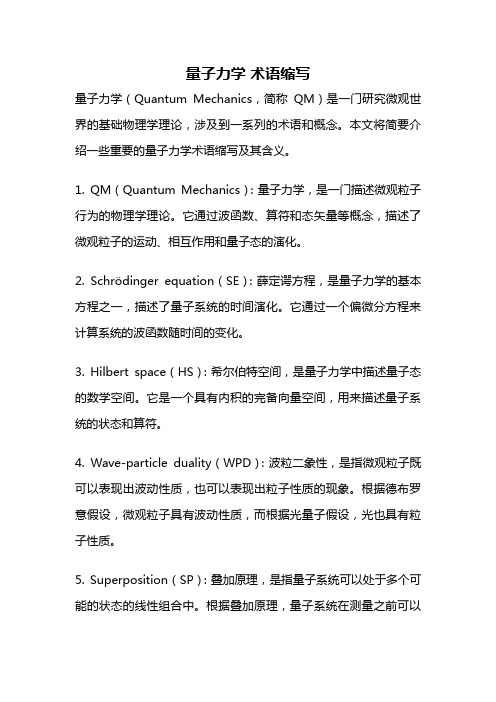
量子力学术语缩写量子力学(Quantum Mechanics,简称QM)是一门研究微观世界的基础物理学理论,涉及到一系列的术语和概念。
本文将简要介绍一些重要的量子力学术语缩写及其含义。
1. QM(Quantum Mechanics):量子力学,是一门描述微观粒子行为的物理学理论。
它通过波函数、算符和态矢量等概念,描述了微观粒子的运动、相互作用和量子态的演化。
2. Schrödinger equation(SE):薛定谔方程,是量子力学的基本方程之一,描述了量子系统的时间演化。
它通过一个偏微分方程来计算系统的波函数随时间的变化。
3. Hilbert space(HS):希尔伯特空间,是量子力学中描述量子态的数学空间。
它是一个具有内积的完备向量空间,用来描述量子系统的状态和算符。
4. Wave-particle duality(WPD):波粒二象性,是指微观粒子既可以表现出波动性质,也可以表现出粒子性质的现象。
根据德布罗意假设,微观粒子具有波动性质,而根据光量子假设,光也具有粒子性质。
5. Superposition(SP):叠加原理,是指量子系统可以处于多个可能的状态的线性组合中。
根据叠加原理,量子系统在测量之前可以同时处于多个可能的状态,而测量结果将只能得到其中一个确定的状态。
6. Entanglement(EN):纠缠,是指两个或多个量子系统之间存在一种特殊的关联状态,使它们的状态无法被独立描述。
纠缠是量子系统之间的一种非经典的相互作用,具有远距离的关联性。
7. Measurement problem(MP):量子测量问题,是指当对一个量子系统进行测量时,我们无法预测测量结果的确切值,只能得到一系列可能的测量结果及其概率。
量子测量问题是量子力学的一个基本困惑,目前仍然存在争议。
8. Uncertainty principle(UP):不确定性原理,是指在量子力学中,某些物理量的测量值无法同时被确定到最高精度。
Fluctuation theorem for entropy production during effusion of a relativistic ideal gas
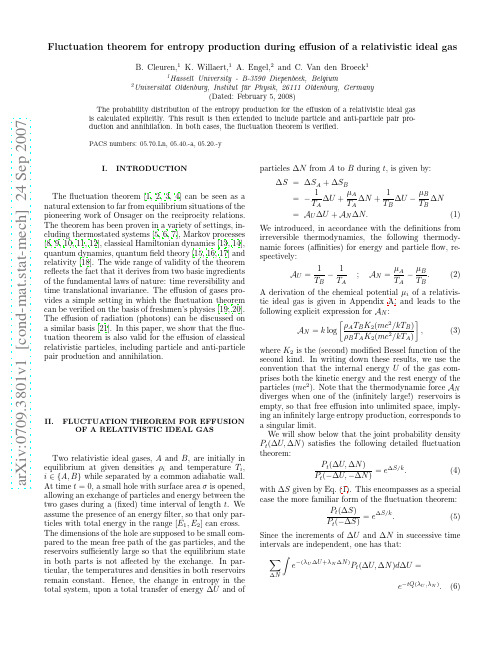
−e
−
“
1 kTi
” +λ E2
1 + λU kTi 1 + λU 2 + 2E2 kTi 1 + λU kTi
2
During a small time interval dt, the contributions to quantities ∆U and ∆N result from individual particle transport across the hole. Following basic arguments from kinetic theory of gases the corresponding probabilities per unit time, TA→B (E ) and TB →A (E ), to observe a particle with energy E crossing the hole from i → j is given by (cf. Appendix B): (mc2 /kTi )e kTi σρi (E 2 − m2 c4 ). (8) Ti→j (E ) = 2 4c (mc)3 K2 (mc2 /kTi )
Fluctuation theorem for entropy production during effusion of a relativistic ideal gas
B. Cleuren,1 K. Willaert,1 A. Engel,2 and C. Van den Broeck1
2 1 Hasselt University - B-3590 Diepenbeek, Belgium Universit¨ at Oldenburg, Institut f¨ ur Physik, 26111 Oldenburg, Germany (Dated: February 5, 2008)
超分子相互作用诱导有机分子自组装引起超长管状晶体的波导和自发辐射放大
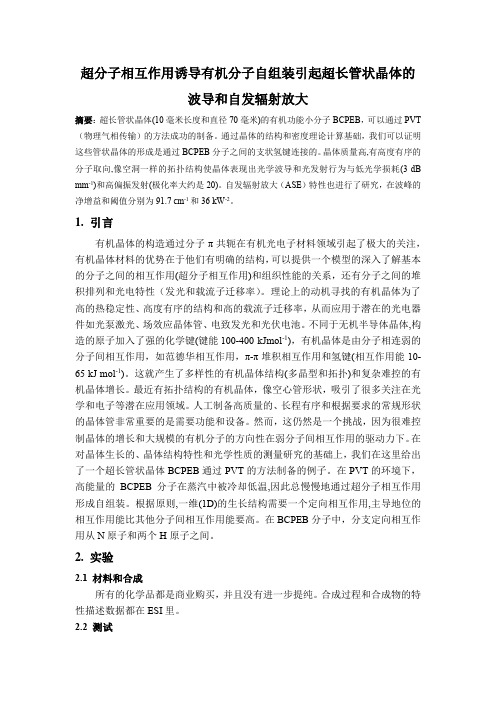
超分子相互作用诱导有机分子自组装引起超长管状晶体的波导和自发辐射放大摘要:超长管状晶体(10毫米长度和直径70毫米)的有机功能小分子BCPEB,可以通过PVT (物理气相传输)的方法成功的制备。
通过晶体的结构和密度理论计算基础,我们可以证明这些管状晶体的形成是通过BCPEB分子之间的支状氢键连接的。
晶体质量高,有高度有序的分子取向,像空洞一样的拓扑结构使晶体表现出光学波导和光发射行为与低光学损耗(3 dB mm-1)和高偏振发射(极化率大约是20)。
自发辐射放大(ASE)特性也进行了研究,在波峰的净增益和阈值分别为91.7 cm-1和36 kW-2。
1.引言有机晶体的构造通过分子π共轭在有机光电子材料领域引起了极大的关注,有机晶体材料的优势在于他们有明确的结构,可以提供一个模型的深入了解基本的分子之间的相互作用(超分子相互作用)和组织性能的关系,还有分子之间的堆积排列和光电特性(发光和载流子迁移率)。
理论上的动机寻找的有机晶体为了高的热稳定性、高度有序的结构和高的载流子迁移率,从而应用于潜在的光电器件如光泵激光、场效应晶体管、电致发光和光伏电池。
不同于无机半导体晶体,构造的原子加入了强的化学键(键能100-400 kJmol-1),有机晶体是由分子相连弱的分子间相互作用,如范德华相互作用,π-π堆积相互作用和氢键(相互作用能10-65 kJ mol-1)。
这就产生了多样性的有机晶体结构(多晶型和拓扑)和复杂难控的有机晶体增长。
最近有拓扑结构的有机晶体,像空心管形状,吸引了很多关注在光学和电子等潜在应用领域。
人工制备高质量的、长程有序和根据要求的常规形状的晶体管非常重要的是需要功能和设备。
然而,这仍然是一个挑战,因为很难控制晶体的增长和大规模的有机分子的方向性在弱分子间相互作用的驱动力下。
在对晶体生长的、晶体结构特性和光学性质的测量研究的基础上,我们在这里给出了一个超长管状晶体BCPEB通过PVT的方法制备的例子。
(完整版)量子力学英语词汇
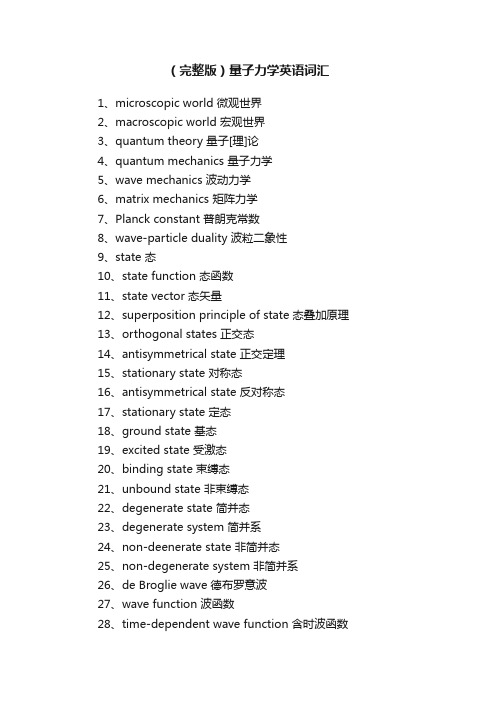
(完整版)量子力学英语词汇1、microscopic world 微观世界2、macroscopic world 宏观世界3、quantum theory 量子[理]论4、quantum mechanics 量子力学5、wave mechanics 波动力学6、matrix mechanics 矩阵力学7、Planck constant 普朗克常数8、wave-particle duality 波粒二象性9、state 态10、state function 态函数11、state vector 态矢量12、superposition principle of state 态叠加原理13、orthogonal states 正交态14、antisymmetrical state 正交定理15、stationary state 对称态16、antisymmetrical state 反对称态17、stationary state 定态18、ground state 基态19、excited state 受激态20、binding state 束缚态21、unbound state 非束缚态22、degenerate state 简并态23、degenerate system 简并系24、non-deenerate state 非简并态25、non-degenerate system 非简并系26、de Broglie wave 德布罗意波27、wave function 波函数28、time-dependent wave function 含时波函数29、wave packet 波包30、probability 几率31、probability amplitude 几率幅32、probability density 几率密度33、quantum ensemble 量子系综34、wave equation 波动方程35、Schrodinger equation 薛定谔方程36、Potential well 势阱37、Potential barrien 势垒38、potential barrier penetration 势垒贯穿39、tunnel effect 隧道效应40、linear harmonic oscillator 线性谐振子41、zero proint energy 零点能42、central field 辏力场43、Coulomb field 库仑场44、δ-function δ-函数45、operator 算符46、commuting operators 对易算符47、anticommuting operators 反对易算符48、complex conjugate operator 复共轭算符49、Hermitian conjugate operator 厄米共轭算符50、Hermitian operator 厄米算符51、momentum operator 动量算符52、energy operator 能量算符53、Hamiltonian operator 哈密顿算符54、angular momentum operator 角动量算符55、spin operator 自旋算符56、eigen value 本征值57、secular equation 久期方程58、observable 可观察量59、orthogonality 正交性60、completeness 完全性61、closure property 封闭性62、normalization 归一化63、orthonormalized functions 正交归一化函数64、quantum number 量子数65、principal quantum number 主量子数66、radial quantum number 径向量子数67、angular quantum number 角量子数68、magnetic quantum number 磁量子数69、uncertainty relation 测不准关系70、principle of complementarity 并协原理71、quantum Poisson bracket 量子泊松括号72、representation 表象73、coordinate representation 坐标表象74、momentum representation 动量表象75、energy representation 能量表象76、Schrodinger representation 薛定谔表象77、Heisenberg representation 海森伯表象78、interaction representation 相互作用表象79、occupation number representation 粒子数表象80、Dirac symbol 狄拉克符号81、ket vector 右矢量82、bra vector 左矢量83、basis vector 基矢量84、basis ket 基右矢85、basis bra 基左矢86、orthogonal kets 正交右矢87、orthogonal bras 正交左矢88、symmetrical kets 对称右矢89、antisymmetrical kets 反对称右矢90、Hilbert space 希耳伯空间91、perturbation theory 微扰理论92、stationary perturbation theory 定态微扰论93、time-dependent perturbation theory 含时微扰论94、Wentzel-Kramers-Brillouin method W. K. B.近似法95、elastic scattering 弹性散射96、inelastic scattering 非弹性散射97、scattering cross-section 散射截面98、partial wave method 分波法99、Born approximation 玻恩近似法100、centre-of-mass coordinates 质心坐标系101、laboratory coordinates 实验室坐标系102、transition 跃迁103、dipole transition 偶极子跃迁104、selection rule 选择定则105、spin 自旋106、electron spin 电子自旋107、spin quantum number 自旋量子数108、spin wave function 自旋波函数109、coupling 耦合110、vector-coupling coefficient 矢量耦合系数111、many-particle system 多子体系112、exchange forece 交换力113、exchange energy 交换能114、Heitler-London approximation 海特勒-伦敦近似法115、Hartree-Fock equation 哈特里-福克方程116、self-consistent field 自洽场117、Thomas-Fermi equation 托马斯-费米方程118、second quantization 二次量子化119、identical particles 全同粒子120、Pauli matrices 泡利矩阵121、Pauli equation 泡利方程122、Pauli’s exclusion principle泡利不相容原理123、Relativistic wave equation 相对论性波动方程124、Klein-Gordon equation 克莱因-戈登方程125、Dirac equation 狄拉克方程126、Dirac hole theory 狄拉克空穴理论127、negative energy state 负能态128、negative probability 负几率129、microscopic causality 微观因果性本征矢量eigenvector本征态eigenstate本征值eigenvalue本征值方程eigenvalue equation本征子空间eigensubspace (可以理解为本征矢空间)变分法variatinial method标量scalar算符operator表象representation表象变换transformation of representation表象理论theory of representation波函数wave function波恩近似Born approximation玻色子boson费米子fermion不确定关系uncertainty relation狄拉克方程Dirac equation狄拉克记号Dirac symbol定态stationary state定态微扰法time-independent perturbation定态薛定谔方程time-independent Schro(此处上面有两点)dinger equation 动量表象momentum representation 角动量表象angular mommentum representation占有数表象occupation number representation坐标(位置)表象position representation角动量算符angular mommentum operator角动量耦合coupling of angular mommentum对称性symmetry对易关系commutator厄米算符hermitian operator厄米多项式Hermite polynomial分量component光的发射emission of light光的吸收absorption of light受激发射excited emission自发发射spontaneous emission轨道角动量orbital angular momentum自旋角动量spin angular momentum轨道磁矩orbital magnetic moment归一化normalization哈密顿hamiltonion黑体辐射black body radiation康普顿散射Compton scattering基矢basis vector基态ground state基右矢basis ket ‘右矢’ket基左矢basis bra简并度degenerancy精细结构fine structure径向方程radial equation久期方程secular equation量子化quantization矩阵matrix模module模方square of module内积inner product逆算符inverse operator欧拉角Eular angles泡利矩阵Pauli matrix平均值expectation value (期望值)泡利不相容原理Pauli exclusion principle氢原子hydrogen atom球鞋函数spherical harmonics全同粒子identical particles塞曼效应Zeeman effect上升下降算符raising and lowering operator 消灭算符destruction operator产生算符creation operator矢量空间vector space守恒定律conservation law守恒量conservation quantity投影projection投影算符projection operator微扰法pertubation method希尔伯特空间Hilbert space线性算符linear operator线性无关linear independence谐振子harmonic oscillator选择定则selection rule幺正变换unitary transformation幺正算符unitary operator宇称parity跃迁transition运动方程equation of motion正交归一性orthonormalization正交性orthogonality转动rotation自旋磁矩spin magnetic monent(以上是量子力学中的主要英语词汇,有些未涉及到的可以自由组合。
Particle swarms in optimization and control
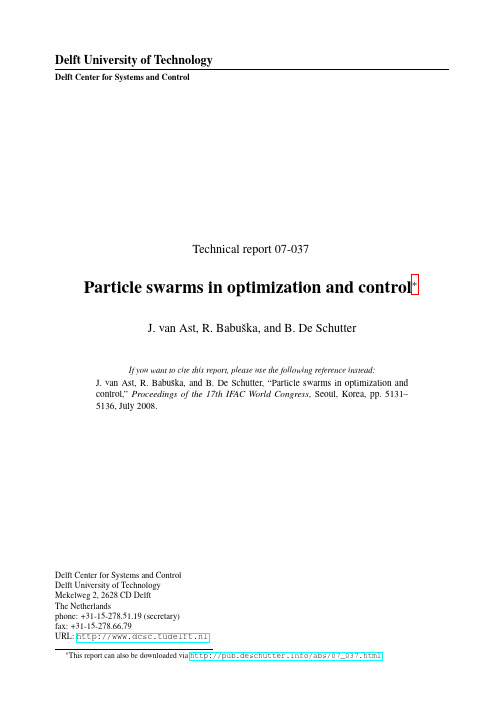
Delft University of TechnologyDelft Center for Systems and ControlTechnical report07-037Particle swarms in optimization and control∗J.van Ast,R.Babuˇs ka,and B.De SchutterIf you want to cite this report,please use the following reference instead: J.van Ast,R.Babuˇs ka,and B.De Schutter,“Particle swarms in optimization andcontrol,”Proceedings of the17th IFAC World Congress,Seoul,Korea,pp.5131–5136,July2008.Delft Center for Systems and ControlDelft University of TechnologyMekelweg2,2628CD DelftThe Netherlandsphone:+31-15-278.51.19(secretary)fax:+31-15-278.66.79URL:http://www.dcsc.tudelft.nl∗This report can also be downloaded via /abs/07_037.htmlParticle Swarms in Optimization and Control⋆Jelmer van Ast∗Robert Babuˇs ka∗Bart De Schutter∗,∗∗∗Delft Center for Systems and Control,∗∗Marine and Transport Technology,Delft University of Technology,Mekelweg2,2628CD Delft,The Netherlands.Abstract:In the last decennium,particle swarms have received considerable attention in the fields of optimization and control.Inspired by swarms of social animals,such as birds,fish,and termites,simple behavior on the local level has been shown to result in useful complex behavior on the global level.Particle Swarm Optimization has proven to be a very powerful optimization heuristic,and swarm aggregation based on artificial potentialfields enjoys a growing interest for controlling particles in a swarm.Especially theflexibility,scalability,and robustness to errors on a local level are intrinsic properties of swarms that have attracted the interest of researchers in applying swarm technology to various problems.In this contribution,we present an overview of the application of particle swarms for optimization and control of swarm aggregation.1.INTRODUCTIONIn recent years,the collective behavior of large numbers of moving cooperative agents,frequently called particles, has proven to be useful in thefields of optimization and control.The collection of these particles is called a swarm and its application is referred to as swarm intelligence. The power of swarm intelligence is that simple behavior on the local level can result in useful,often more complex, behavior on the global level.Even if the individual agents are too simple for the label‘intelligent’,the swarm often does manifest intelligent behavior.The global behavior of the swarm is difficult to predict based on the local dynamics of the particles.A number of publications, such as(Clerc and Kennedy,2002;Gazi,2005;Gazi and Fidan,2007;Jadbabaie et al.,2003),has however set the foundations for the analysis and application of swarm intelligence.This paper briefly reviews the major advances of swarm intelligence,analyzed from the viewpoint of optimization and control.Swarming is a term from biology denoting the collective motion of a group of insects,bacteria,or groups of animals. Swarm intelligence is inspired by biological social animals, such asflocks of birds,schools offish,and herds of running animals.Reynolds(1987)has demonstrated a visually attractive simulation offlocking by implementing only three basic local rules for each virtual bird,or boid (i.e.,bird-oid).These rules were:flock centering,collision avoidance,and velocity matching.In a similar study, Vicsek et al.(1995)demonstrate theflocking of bird-like particles by averaging theflight direction of each particle with that of its neighbors.These results have been analyzed mathematically in(Jadbabaie et al.,2003).A quantitative study using a kinematic model of group motion is given by Okubo(1986).Gr¨u nbaum(1998)shows how schooling helps animals tofind food sources in a noisy environment.⋆This research isfinancially supported by Senter,Ministry of Economic Affairs of The Netherlands within the BSIK-ICIS project “Self-Organizing Moving Agents”(grant no.BSIK03024).Swarms have many advantages when compared to their individual members.In biological swarms,the group often offers protection from predators(school offish,herd of antelopes),more efficient motion(flock of birds),or more effective food collection(ants,termites).In general,a swarm may complete tasks that are impossible to complete by the individuals alone.The characteristics of a swarm can be summarized as follows:•A swarm consists of a set of cooperating autonomous individuals.•The individuals have their own strategies they aim to satisfy and they are not aware of the global objective.•Each individual locally interacts with the environ-ment and communicates with its neighbors.•There is neither a supervisor,nor afixed and prede-fined hierarchical structure.The swarms approach to distributed systems of moving agents is slowlyfinding a way to engineering applications, such as controlling platoons of vehicles on freeways(Liu et al.,2001),robot navigation(Feddema et al.,2002), and control of unmanned aerial vehicles(Deming and Perlovsky,2007).The most important intrinsic advantages of swarms in engineering applications are:•Simple homogenous individuals can be produced in series,resulting in lower production costs.•The swarm is potentially robust to errors of the individuals,so the individuals can be made of rel-atively unreliable components.Malfunctioning indi-viduals can easily be removed,or replaced.•Scalability;individuals can easily be added,or re-moved.Generally,in multi-agent systems,the coordination of the agents is achieved by complex strategies,in afixed topology.Often a central controller is used to determine the optimal action for each of the agents.Such methods, however,scale poorly with the number of agents.Swarm intelligence aims at controlling a large number of coop-erative autonomous agents,in a varying topology,with simple,local rules.The analysis of a swarm intelligencesystem typically focuses on the dynamics of the swarm as a whole,rather than on the dynamics of the individual agents.In this paper,the application of swarm intelligence to optimization and control is considered.This overview is particularly useful as a concise review of the state of the art of these subjects.The most prevalent method regarding optimization is Particle Swarm Optimization(PSO).In PSO,the individual particles influence each other in their search for the optimum in a certain parameter space and in many cases,the swarm as a whole converges to this optimum.Regarding swarm intelligence for control,the most prevalent control problem is Swarm Aggregation,in which the particles have to form a cohesive swarm with certain characteristics,such as size,shape,and location in the environment.This paper discusses the method of artificial potentialfields,which has received increased at-tention in the recent literature.In this method,attraction and repulsion forces are assigned to all objects in the environment.The particles move based on the nett force of the potentialfield.This method is a more general way of implementing the rules,defined by(Reynolds,1987). The rest of this paper is structured as follows.In Section2, swarm intelligence for optimization is discussed.Section3 discusses the modeling,control,and analysis of swarms of particles moving in two or three dimensions,and Section4 concludes this paper.2.PARTICLE SWARM OPTIMIZATIONIn many optimization problems,the size of the search space rapidly increases with the number of variables and the domain of the values they can take.Finding an opti-mum in these search spaces quickly becomes an intractable problem,due to what is referred to as the curse of dimen-sionality.Rather thanfinding the global optimal solution, optimization heuristics have been developed tofind suf-ficiently good solutions in polynomial time(Dorigo and St¨u tzle,2004).Swarm intelligence presents a class of such heuristics.Particle Swarm Optimization(PSO)(Kennedy and Eber-hart,1995)has been developed to solve nonlinear multi-dimensional optimization problems.In analogy toflocks of birds,PSO casts the optimization problem in a parameter space,through which a set of particlesflies.However,as opposed to birds,whichfly in a three-dimensional space, the space of the particles can be of arbitrary dimension. The nonlinear function,the optimum of which needs to be found,maps the parameters tofitness values.The particles search on the local level and keep one another updated on the best solutions(associated with higherfitness values) found so far,so that they are biased towards more promis-ing regions of the search space.2.1PSO Update RuleIn PSO,the problem state space is defined as X⊆R n, with x i(k)the position of a particle i and v i(k)its velocity at time k.After initialization,the particles update their state in each iteration of the algorithm,with the following rule:v i(k+1)=w(k)v i(k)+c1r1(k)[x i,pbest(k)−x i(k)]+c2r2(k)[x i,lbest(k)−x i(k)](1) x i(k+1)=x i(k)+v i(k),(2) where k is the current time step,x i,pbest(k)is the personalbest position,x i,lbest(k)is the local best position,w(k)is the inertia weight,r1,2(k)are random variables,and c1,2 are positive acceleration constants.In each iteration,afitness function F:X→R is evaluated for the values of x i(k)and compared to the personal best values x i,pbest(k).If a better value,corresponding to a higherfitness,has been found for a particle i,its personal best value is replaced by x i(k).If the maximum of x i(k)over all i in some neighborhood is higher than the current x i,lbest(k),the latter value is replaced by that value.Sometimes,the neighborhood is considered to cover the complete swarm.In that case,the local best is called the global best position of a particle,x i,gbest(k).Each particle in the swarm is attracted towards its personal best solution and its local best solution.In this way,it learns tofind the optimum of thefitness function,not only by its own experience,but from other members of the swarm as well.The values of the inertia weight w(k) and the range of the random variables r1,2(k)influence the convergence properties of the particle swarm.The positive acceleration constants c1,2trade offexploration and exploitation.The convergence of PSO has been proven in(Clerc and Kennedy,2002)and in(Kadirkamanathan et al.,2006).2.2Variations on the Basic Update RuleAs PSO is a very activefield of research,new variations are proposed continuously.Some include special rules of selecting the local best position,moving particles to ran-dom places in the environment,and information exchange between multiple cooperating swarms(Baskar and Sug-anthan,2004;El-Abd and Kamel,2005;Kennedy and Eberhart,2001).Other authors propose new PSO-like methods inspired by other biological counterparts,such as the immune system(Afshinmanesh et al.,2005). Apart from PSO,another interesting swarm intelligence optimization heuristic is Ant Colony Optimization(Dorigo and St¨u tzle,2004;Dorigo and Blum,2005).Ant Colony Optimization(ACO)has proven to be successful atfinding good solutions in polynomial time to many NP-complete combinatorial optimization problems.Agents are modeled as ants traversing the nodes of a graph,representing the optimization problem.Traversing a node corresponds to adding it to a partial solution.In ACO,the agents communicate by pheromones,or values assigned to the connections between the nodes,which influence the prob-ability for other agents to traverse these connections.It is proven that this mechanism results in a convergence of the solutions constructed by all the agents to the optimal combination of nodes and connections(Dorigo and St¨u tzle, 2004;Dorigo and Blum,2005).2.3Applications of PSOPSO has successfully been applied to many optimization problems.Chen et al.(2006)and Gaing(2004)apply PSOto the tuning of PID controllers.Training of feedforward neural networks is described in(Kennedy and Eberhart, 2001).In thefield of control of power plants,PSO has also been applied in(Heo et al.,2006;Gaing,2004).Several other applications of PSO include the synthesis of antenna arrays(Chen et al.,2005),clustering in mobile ad hoc networks(Ji et al.,2004),and traffic incident detection (Srinivasan et al.,2003).For a more detailed description of the basic update rule,its variations,and application areas,please refer to(Kennedy and Eberhart,2001)and the references therein.That paper also contains a nice overview of the relation between swarm intelligence,biologicalflocking,and thefield of evolutionary computation.2.4Concluding RemarksThe previous discussion has briefly presented the appli-cability of swarms for optimization.Rather than solving the problem analytically,or in an enumerative way,the particles in the swarm influence each other such that they are driven towards more promising regions of the search space,in which they eventually converge to the optimum. The next section describes methods for controlling swarm aggregation.In contrast to optimization,the control objec-tive is not anymore for the particles to converge to a single point in a parameter space,but to form a cohesive swarm with some specific characteristics,such as size,shape,and location.3.CONTROLLING A PARTICLE SWARMThe control of a swarm of moving agents has mainly focused on three control problems:rendezvous,formation control,and swarm aggregation.An overview of these problems and associated controller design can be found in(Martinez et al.,2007).The rendezvous problem is tofind control strategies under which all the agents in the swarm group eventually agree on and reach a single common location.This problem is analyzed for synchronous communication,where the agents communicate synchronized with a common clock, as well as the asynchronous case in(Lin et al.,2003,2004). The rendezvous problem also relates to the distributed consensus problem,which is clearly covered in(Olfati-Saber et al.,2007).This paper presents stability and per-formance conditions of the swarm based on the properties of the graph Laplacian,describing the connectivity of the individuals.Formation control refers to the control problem where the agents need to control their distance to other agents,as specified in a formation graph.Typically,the formation needs to be maintained while the agents follow a trajectory and may encounter obstacles.Formation control is studied in,e.g.,(Gazi and Fidan,2007),in which rigid graph theory is used to analyze the properties of the formation in various conditions.This study also includes an overview of the control problems related to formation control,such as splitting and merging of formations.Swarm aggregation deals with the control problem in which the agents have to aggregate to form a cohesive swarm.Controlling a swarm is a difficult task.The large number of particles and interactions makes explicit analysis of the motion of all the particles rapidly infeasible.This paper focuses on swarm aggregation as the control problem of interest.The main method for controlling the motion of the particles uses artificial potentialfields.This method is considered in,e.g.,(Barnes et al.,2006;Chu et al.,2006; Gazi and Passino,2003,2004b,a,2005;Gazi,2005;Kim et al.,2006;Liu et al.,2003b,a;Liu and Passino,2004).3.1Particle DynamicsSwarm aggregation is the convergence of a set of particles to a cohesive swarm in an environment defined by a state x∈X⊆R n,with X the state space and n the dimension of the state space.When analyzing large distributed systems,it is convenient to start with a simple model of the particle dynamics and their interaction.The particles are modeled by a simple kinematic model:˙x i(t)=u i(t),(3) where the position of a particle i at time t is denoted by x i(t)and its corresponding input by u i(t).This model allows proof-of-concept design of swarm systems,where at a later stage,the particle dynamics(3)can be replaced by a more realistic model,like a point-mass model or full-actuator model.The full actuator model has been considered in(Gazi and Passino,2005).In(Gazi and Fidan,2007),more models are described,such as the non-holonomic unicycle model,Dubins’vehicle model,and the self-propelled particle model.The interested reader is referred to that paper and the references therein.3.2Artificial Potential FieldsIn the environment,all the objects,such as the particles and obstacles are assigned a certain potential function, which defines the force acting upon a particle at a certain distance.The value of the artificial potentialfield is the sum of the values of all the potential functions.The input to the particle dynamics(3)is the local value of the artificial potentialfield.For N particles present in an obstacle-free environment,(3)becomes:˙x i(t)=Nj=1,j=i g i(x i(t)−x j(t)),for i=1,...,N(4)where g i(x i(t)−x j(t))represents the potential function assigned to particle i that governs the attraction and repulsion of the particles in the swarm.Note that each particle may have its own potential function.This means that particles may have potential functions that are differ-ent in structure,or have the same structure,but different parameter values.A swarm in which at least one particle has a different potential function from the other particles, is called a heterogeneous swarm.When all the particles have the same potential functions,the swarm is said to be homogeneous.Although this framework allows for het-erogeneous swarms,almost all the research published is on the analysis and control of homogeneous swarms.The main reason for this is that proving convergence for het-erogeneous swarms is much more involving than for homo-geneous swarms.The general class of attraction/repulsionfunctions for which convergence is proven in (Gazi and Passino,2004a)is of the type:g (y )=−y [g a (||y ||)−g r (||y ||)],(5)where g a :R +→R +and g r :R +→R +represent the magnitude of the attraction and repulsion term respec-tively and ||y ||=y T y is the Euclidean norm.Here,the vector y represents the distance between two particles y =x i −x j ,for i,j ∈{1,...,M }.The explicit dependence on time is left out for the sake of brevity.One particular function that is frequently used to model the particles is:g (y )=−ya −b exp−||y ||2c,(6)with a,b,and c positive constants such that b >a .Forlarge distances,a dominates and the function is attractive.For small distances,the term b exp −||y ||2cdominates and the function is repulsive.The function (6)is plotted in Fig.1for a scalar y and for several values of theparameters.yg (y )Fig.1.The particle potential function (6)for several valuesof the parameters.We can deduce from the motion equation (4)and the potential function (6)that the sign of the velocity of the particles changes at the set of points Y ={g (y )=0}={y =0or ||y ||=δ= c ln(b/a )},i.e.,when the particles cross each other,or when they are at a distance δknown as the comfortable distance .The equilibrium y =0is unstable,so the particles will move away from each other when crossing.The set of equilibrium points ||y ||=δis stable because the force from the potential function drives the state of the particles to this equilibrium.The swarm will thus converge to the state where each individual reaches its comfortable distance with respect to all the other individuals.Note that in this analysis,the particles are allowed to move through each other,and collisions are not considered.Collision avoidance based on potential functions is addressed in,e.g.,(Barnes et al.,2006)and (Kim et al.,2006).Obstacles can also be modeled by potential functions.A typical potential function for an obstacle is:g (y )=−sign(y ) −b exp −||y ||2c,(7)where sign(y )=1for y ≥0and sign(y )=−1for y <0.The attraction term g a of (5)is set to 0,b to a high value so the repulsion is large and collisions are avoided,and c set to a value determining the range of influence,which acts as a safety margin to the obstacle.3.3Aggregation in a Nutrient ProfileGazi and Passino (2004b)consider an extension of the motion dynamics from (4)by including a term σ(x ):R n →R representing the nutrient profile.The term nutrient stems from its analogy with the environment in which insects forage their nutrients.The profile contains the attractant/repellent parts of the environment and the motion equation for each particle becomes:˙xi =−∇x σ(x i )+N +Oj =1,j =ig i (x i −x j ),for i =1,...,N,where the term −∇x σ(x i )represents negative gradient of the nutrient profile as measured by a particle i .It results in the motion of the individual particles toward the attractive regions and away from the more repellent regions.The number of obstacles is denoted by O ,with the obstacles indexed from N +1to N +O .The nutrient profile presents a way to control the position of the swarm in the environment.A changing nutrient profile can represent a moving setpoint for trajectory tracking.The introduction of a nutrient profile shows similarities with PSO,in which the particles are controlled to the global optimum in a parameter space.However,the nutrient profiles studied by Gazi and Passino (2004b);Liu et al.(2007)are smooth functions,without local optima,whereas typical optimization problems solved by PSO contain many local optima (Kennedy and Eberhart,2001).3.4Convergence and StabilityConvergence and stability analysis of swarm aggregation based on artificial potential fields is not trivial.The poten-tial field contains many local optima and changes contin-uously as the particles move and have a varying distance to the other objects while aggregating.Convergence and stability proofs are mainly published in (Gazi and Passino,2003,2004a;Gazi,2005;Liu et al.,2003b).Gazi and Passino (2003)have proved that the motion of the particles over time is towards the center of the swarm.As time progresses,all members of the swarm will converge to a hyperballB ǫ(x )={x i :||x i −x ||≤ǫ},∀i =1,...,N,whereǫ=b ac 2exp(−12)is the swarm size andx=1NN i=1x i,the swarm center.Moreover,they prove that the conver-gence will occur infinite time.They also provide a bound on the swarm size forfinite number of agentsǫN,asǫN=b(N−1)aNc2exp −12 .This quantity is always smaller thanǫforfinite values of N and when N→∞,this bound becomes equal toǫ.In other words,ǫis the largest possible bound on the swarm size,independent of the number of particles in the swarm. This result is very conservative,in the sense that it tells nothing about other properties of the swarm,such as the shape,orientation,and distribution of the particles within this hyperball.A detailed analysis of the convergence of the swarm to such macroscopic characteristics has not been published yet.In relation to formation control,the convergence to charac-teristics on a local level,such as the exact distance between all the particles is studied in(Gazi,2005).He proved the convergence of the swarm when formation constraints are added to(4):||x i−x j||=d i,j,for i,j=1,...,N,with d i,j the desired distance between two particles i,j in the swarm.3.5Concluding RemarksThis section has presented the main results for the control of swarm aggregation using artificial potentialfields for modeling the interaction between the particles and other objects in the environment.Artificial potentialfields pro-vide a general and convenient way of modeling the influ-ence of all the objects in the environment on the particle motion.However,the resulting potentialfield generally contains many local optima and is varying in time due to the continuous motion of the particles while aggregating. For these reasons,the analysis and application of this method has been limited to simplified scenarios.The same holds for the application of potential functions to control real swarm robotic systems.This approach can be used when the robots are capable of determining the distance between them and the other objects in the environment,and when they know the potential functions associated to them.Most of the research on particle swarms has been done on an analysis and simulation basis. Results on swarm aggregation are almost always regarded as proofs of concept,because the motion dynamics of the particles do not correspond to the dynamics of realistic agents.4.CONCLUSIONSThis paper has presented an overview of the modeling and control of particle swarms applied to global non-linear optimization and swarm aggregation.Particle Swarm Op-timization has been reviewed as an optimization heuristic in which virtual particles often converge to the global optimal value in the search space,even in the presence of local optima.Regarding the control of real moving agent systems,swarm aggregation has been reviewed as a method in which the agents,modeled as particles,are controlled to form a cohesive swarm.The concept of con-trolling the particles in the swarm by artificial potential fields,in which the interaction between the particles and all the objects in the environment is modeled by potential functions has been discussed.Swarm intelligence for controlling large numbers of agents for real-world applications is still far from being realized. The analysis has only proven that homogenous swarms,for a certain class of potential functions and in an obstacle-free environment,converge within a certain hyperball. Analysis of swarms in more realistic circumstances and the development of systematic control design is necessary before swarm intelligence can be applied to practical relevant control problems.REFERENCESAfshinmanesh, F.,Marandi, A.,and Rahimi-Kian, A. (2005).A novel binary particle swarm optimization method using artificial immune system.In Proceedings of the International Conference on Computer as a Tool (EUROCON2005),volume1,217–220.Belgrade,Serbia &Montenegro.Barnes,L.,Alvis,W.,Fields,M.,Valavanis,K.,and Moreno,W.(2006).Swarm formation control with potentialfields formed by bivariate normal functions.In Proceedings of the Mediterranean Conference on Control and Automation(MED2006),1–7.Ancona,Italy. Baskar,S.and Suganthan,P.N.(2004).A novel concurrent particle swarm optimization.In Proceedings of the2004 Congress on Evolutionary Computation(CEC2004), volume1,792–796.Portland,OR,USA.Chen,J.,Ren,Z.,and Fan,X.(2006).Particle swarm optimization with adaptive mutation and its application research in tuning of PID parameters.In Proceedings of the International Symposium on Systems and Control in Aerospace and Astronautics(ISSCAA2006),526–530. Harbin,China.Chen,T.B.,Chen,Y.B.,Jiao,Y.C.,and Zhang, E.S. (2005).Synthesis of antenna array using particle swarm optimization.In Proceedings of the Asia-Pacific Con-ference on Microwave(APMC2005),volume3.Suzhou, China.Chu,T.,Wang,L.,Chen,T.,and Mu,S.(2006).Complex emergent dynamics of anisotropic swarms:convergence vs oscillation.Chaos,Solitons and Fractals,30(4),875–885.Clerc,M.and Kennedy,J.(2002).The particle swarm-ex-plosion,stability,and convergence in a multidimensional complex space.IEEE Transactions on Evolutionary Computation,6(1),58–73.Deming,R.W.and Perlovsky,L.I.(2007).Concurrent multi-target localization,data association,and naviga-tion for a swarm offlying rmation Fusion, 8(3),316–330.Dorigo,M.and Blum,C.(2005).Ant colony optimization theory:a survey.Theoretical Computer Science,344(2-3),243–278.Dorigo,M.and St¨u tzle,T.(2004).Ant Colony Optimiza-tion.The MIT Press,Cambridge,MA,USA.El-Abd,M.and Kamel,M.(2005).Information exchange in multiple cooperating swarms.In Proceedings of the2005IEEE Swarm Intelligence Symposium(SIS 2005),138–142.Pasadena,CA,USA.Feddema,J.T.,Lewis,C.,and Schoenwald,D.A.(2002). Decentralized control of cooperative robotic vehicles: theory and application.IEEE Transactions on Robotics and Automation,18(5),852–864.Gaing,Z.(2004).A particle swarm optimization approach for optimum design of PID controller in AVR system. IEEE Transactions on Energy Conversion,19(2),384–391.Gazi,V.(2005).Swarm aggregations using artificial potentials and sliding-mode control.IEEE Transactions on Robotics,21(6),1208–1214.Gazi,V.and Fidan,B.(2007).Coordination and control of multi-agent dynamic systems:Models and approaches. In E.Sahin,W.Spears,and A.Winfield(eds.),Swarm Robotics,volume4433of Lecture Notes in Computer Science,71–102.Springer-Verlag.Gazi,V.and Passino,K.M.(2003).Stability analysis of swarms.IEEE Transactions on Automatic Control, 48(4),692–697.Gazi,V.and Passino,K.M.(2004a).A class of attractions/ repulsion functions for stable swarm aggregations.In-ternational Journal of Control,77(18),1567–1579. Gazi,V.and Passino,K.M.(2004b).Stability analysis of social foraging swarms.IEEE Transactions on Systems, Man and Cybernetics,Part B,34(1),539–557.Gazi,V.and Passino,K.M.(2005).Stability of a one-dimensional discrete-time asynchronous swarm.IEEE Transactions on Systems,Man and Cybernetics,Part B,35(4),834–841.Gr¨u nbaum,D.(1998).Schooling as a strategy for taxis in a noisy environment.Evolutionary Ecology,12(5), 503–522.Heo,J.S.,Lee,K.Y.,and Garduno-Ramirez,R.(2006). Multiobjective control of power plants using particle swarm optimization techniques.IEEE Transactions on Energy Conversion,21(2),552–561.Jadbabaie,A.,Lin,J.,and Morse,A.S.(2003).Coordina-tion of groups of mobile autonomous agents using near-est neighbor rules.IEEE Transactions on Automatic Control,48(6),988–1001.Ji,C.,Zhang,Y.,Gao,S.,Yuan,P.,and Li,Z.(2004). Particle swarm optimization for mobile ad hoc net-works clustering.In Proceedings of the IEEE Interna-tional Conference on Networking,Sensing and Control, volume1,372–375.Taipei,Taiwan. Kadirkamanathan,V.,Selvarajah,K.,and Fleming,P.J. (2006).Stability analysis of the particle dynamics in particle swarm optimizer.IEEE Transactions on Evo-lutionary Computation,10(3),245–255.Kennedy,J.and Eberhart,R.C.(1995).Particle swarm optimization.In Proceedings of the IEEE Inter-national Conference on Neural Networks,1942–1948. Perth,Western Australia.Kennedy,J.and Eberhart,R.C.(2001).Swarm Intelli-gence.Morgan Kaufmann Publishers Inc.,San Fran-cisco,CA,USA.Kim, D.H.,Wang,H.O.,Ye,G.,and Shin,S.(2006). Decentralized control of autonomous swarm systems using artificial potential functions:analytical design guidelines.Journal of Intelligent and Robotic Systems, 45(4),369–394.Lin,J.,Morse,A.S.,and Anderson,B.D.O.(2003).The multi-agent rendezvous problem.In Proceedings of the42nd IEEE Conference on Decision and Control (CDC2003),volume2,1508–1513.Maui,HI,USA. Lin,J.,Morse,A.S.,and Anderson,B.D.O.(2004).The multi-agent rendezvous problem-the asynchronous case.In Proceedings of the43rd IEEE Conference on Decision and Control(CDC2004),volume2,1926–1931.Paradise Island,Bahamas.Liu,B.,Chu,T.,Wang,L.,and Wang,Z.(2007).Collec-tive motion of a class of social foraging swarms.Chaos, Solitons and Fractals.Liu,X.,Goldsmith,A.,Mahal,S.S.,and Hedrick,J.K. (2001).Effects of communication delay on string sta-bility in vehicle platoons.In Proceedings of the IEEE Conference on Intelligent Transportation Systems,625–630.Oakland,CA,USA.Liu,Y.and Passino,K.M.(2004).Stable social foraging swarms in a noisy environment.IEEE Transactions on Automatic Control,49(1),30–44.Liu,Y.,Passino,K.M.,and Polycarpou,M.M.(2003a). Stability analysis of m-dimensional asynchronous swarms with afixed communication topology.IEEE Transactions on Automatic Control,48(1),76–95. Liu,Y.,Passino,K.M.,and Polycarpou,M.M.(2003b). Stability analysis of one-dimensional asynchronous swarms.IEEE Transactions on Automatic Control, 48(10),1848–1854.Martinez,S.,Cortes,J.,and Bullo,F.(2007).Motion co-ordination with distributed information.IEEE Control Systems Magazine,27(4),75–88.Okubo,A.(1986).Dynamical aspects of animal grouping: swarms,schools,flocks,and herds.Advances in Bio-physics,22,1–94.Olfati-Saber,R.,Fax,J.A.,and Murray,R.M.(2007). Consensus and cooperation in networked multi-agent systems.Proceedings of the IEEE,95(1),215–233. Reynolds,C.W.(1987).Flocks,herds and schools:a dis-tributed behavioral puter Graphics,21(4), 25–34.Srinivasan,D.,Loo,W.H.,and Cheu,R.L.(2003).Traffic incident detection using particle swarm optimization. In Proceedings of the2003IEEE Swarm Intelligence Symposium(SIS2003),144–151.Indianapolis,IN,USA. Vicsek,T.,Czirok, A.,Ben-Jacob, E.,Cohen,I.,and Schochet,O.(1995).Novel type of phase transition in a system of self-driven particles.Physical Review Letters, 75(6),1226–1229.。
Relativistic QFTH - Couplings on the Worldline
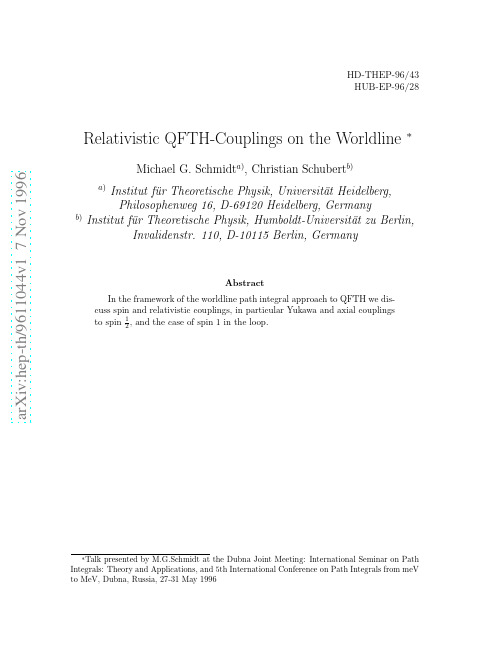
a r X i v :h e p -t h /9611044v 1 7 N o v 1996Relativistic QFTH-Couplings on the Worldline ∗Michael G.Schmidt a ),Christian Schubert b )a )Institut f¨u r Theoretische Physik,Universit¨a t Heidelberg,Philosophenweg 16,D-69120Heidelberg,Germany b )Institut f¨u r Theoretische Physik,Humboldt-Universit¨a t zu Berlin,Invalidenstr.110,D-10115Berlin,GermanyAbstractIn the framework of the worldline path integral approach to QFTH we dis-cuss spin and relativistic couplings,in particular Yukawa and axial couplings to spin 1∗Talk presented by M.G.Schmidt at the Dubna Joint Meeting:International Seminar on Path Integrals:Theory and Applications,and 5th International Conference on Path Integrals from meV to MeV,Dubna,Russia,27-31May 1996IntroductionInteracting relativistic particles are usually described by relativistic local quan-tumfieldmoving on a space-time worldline xµ(τ)and interacting with backgroundfields.We here restrict our discussion to effective1-loop actions,i.e.the particles are running on a closed loop.For a massive complex scalar in the loop one has(euclidean action;singularity at T=0to be renormalized)Γscalar=−log det(−D2+V(x)+m2)= ∞0dT4+ig˙xµ(τ)Aµ(x(τ))+V(φ(x(τ))(2)if one has an(possibly nonabelian,matrix valued in color space)gauge background field and a“potential”(the second derivative of the QFTH-potential),e.g.∼φ,φ2 forφ3,φ4theory resp.Indeed this“first quantization”and the backgroundfield method were used intensively in modern string theory.In particular the recurrence to relativistic particles helped to write down nonlinearσ-models for xµ(σ,τ)on the “world sheet”[2].In the limit string tension1T.(3) It fulfils1∂τ2G B(τ,τ′)=δ(τ−τ′)−1mass”-coordinate of theloop.More general background charges ρ(τ)instead of1Te −m2T∞n =0(−1)n4(6)×τ1=T 0dτ2...τn −1 0dτnnj =1e y (τj )·D V (x (0))+ig ˙y µj (τj )y ρj (τj )1dηj ηj e ηj y (τj )·D F ρj µj (x (0)).In the case where only the potential is present this immediately leads to the minimal number of invariants.Also for the case of gauge interactions it is the most efficient form for obtaining the heat kernel expansion.Such expansions can be used in the calculation of fluctuation corrections around quasiclassical configurations.The effective action (euclidean notation)for gauge fields A µcoupling minimallyto Dirac particles L =¯ψO ψwith O =O +=(∂µ+ig A µ)γµis ΓDirac =log det O =12Tr log(−D 2µ1+gσµνF µν).(7)This contains a Dirac matrix valued potential but otherwise is similar to the scalartheory (“second order formalism”).One can substitute the Dirac matrix trace by a Grassmann variable integration over ψ(τ)[6,5,9]ΓDirac =−2∞dT2ψµ˙ψµ(τ)−igψµ(τ)ψν(τ)F µν(x (τ))(9)with a corresponding Green functionψµ(τ)ψν(τ′) =12δµνsign(τ−τ′).(10)2Surprisingly L D W L is supersymmetric(a remnant of local SUSY),i.e.invariant un-derδxµ=−2ηψµ,δψµ=η˙xµwith a constant Grassmann parameterη,though the boundary conditions break the SUSY.Introducing superfields in superspace ˆτ(τ,θ)( dθθ=1):Xµ(ˆτ)=xµ(τ)+√∂θ−θ∂4DXµD2Xµ−igDXµAµ(X) .(11) Thus the formalism is manifestly supersymmetric[6,8,10]and one can get the effective action with Dirac particles in the loop from the one with scalars by just substituting super Green functionsˆG(ˆτ,ˆτ′)=GB(τ,τ′)+θθ′G F(τ,τ′)(12) in the bosonic calculation.This also explains the so-called“chain”-rule:substitute (index-)closed chains of˙G B(τ,τ′)=∂2couplingsCuriously the Yukawa coupling L Yuk=¯ψ(−iλφ)ψwas not translated to the worldline formulation until our recent work with M.Mondrag´o n and L.Nellen[11]. In a dimensional reduction approach it can be interpreted as a gauge coupling in a fifth dimension(after some redefinition ofγµ).Introducing a new superfield X5=˜x5+√2DX5=√4¯XD¯X+iλφ(Xµ)¯X(ˆτ)=x252ψ5˙ψ5+iλ(x5φ(x)−2ψ5ψµ∂µφ(x)).(14)Integrating out the auxiliaryfield x5we obtain1byΓ=Tr log O=12Tr(log O−log O+)(17)withOO+=−D2+gσµνVµν+g5γ5σµνAµν+iλγµ∂µφ−λ′γ5γµ∂µφ′+2(im+iλφ−γ5λ′φ′)ig5γ5γµAµ+m2+2mλφ+λ2φ2+λ′2φ′2(18) where Vµν,Aµνare thefield strengths.The derivative of the second term in(17) with respect to the backgroundfield U(U=A,φ′in the following)can be written asδδUO+−OδO+OO+ .(19) This“second order”formalism can be translated to the worldline formulation with a purely Grassmann even Lagrangian if one introduces two additional superfields¯X and X′appearing in the coupling to scalars/pseudoscalars as in(14).The new piece of the worldline action is particularly simple if expressed in superfields.We proposed[13]S W L= dτdθ 14¯XD¯X+1eθχgaugefixed to e= 2,χ=0on the circle.The form of the axial coupling with both¯X,X′involved is surprising.Written out in components this is a lengthy expression[13].The imaginary part(19)can be worked out and also translated to worldline languageΓ′U=δT [DXµ][D¯X][DX′](−1)FΩU e−S W L(21)withΩφ′=−iλ′√4D2XµDXµ+1We have tested our worldline action by calculating[13]a collection of ampli-tudesfirst in the conventional Dirac-Feynman,then in second order,andfinally in the worldline formalism.In particular,we could reproduce PCAC and the axial anomaly;we can also derive higher order terms in the1-loop effective action.In recent publications[14,16]it was argued that O and O+can be arranged in a8×8spinor matrix corresponding to a6-dimensional space,thus explaining the need for ourfields¯X,X′.The6-dimensionalγ-matrices can be substituted by Grassmannψ’s and our worldline Lagrangian is reproduced and generalized in an elegant way.There is a subtle technical point[13,17]about either integrating out the auxiliaryfields x5,x6belonging to¯X,X′or contracting them in Green functions if the correctfield theory results are to be obtained.Spin1in the loopThe case of massless spin1gauge bosons coupling to a gauge boson background is particularly important in QCD applications.In the covariant’t Hooft-Feynman background gauge the1-loop action has the Schwinger formΓ(A)=1TTr exp(−ˆhT)(23)with the(color and Lorentz)matrix valued Hamiltonianˆh abµν=−D acρD cbρδµν−2ig F abµν(x).(24) One can evaluate this by a“bosonized”worldline path integral including a matrix valued potential but motivated by the spin1∂xµ,ˆ¯ψ=∂2limC→∞ ∞0dT2antiper.− per. [Dψµ][D¯ψµ]×Tr P exp − T0dτ ˙x2µand fermionic Green functionsG C per.=− θ(−τ)±θ(τ)e−CT e Cτ/(1∓e−CT)(27) antiper.similar but not identical to the expressions in[5].We should stress that(26)is the result of a rigorous derivation,will lead to correct gluon amplitudes,and thus is a good starting point for deriving Bern-Kosower type1-loop rules.As a simple application we have rederived[18]the1-loop action in a constant pseudo-abelian background.Considering the multiloop case it is not so obvious that introducing Grassmann variables to represent spin is an equally efficient way as it is for spin1References[1]R.P.Feynman,Phys.Rev.80(1950)440[2]E.S.Fradkin,A.A.Tseytlin,Phys.Lett.B163(1985)123[3]R.R.Metsaeev,A.A.Tseytlin,Nucl.Phys.B298(1988)109[4]Z.Bern,D.A.Kosower,Phys.Rev.Lett.66(1991)1669;Nucl.Phys.B379(1992)451[5]M.J.Strassler,Nucl.Phys.B385(1992)145;SLAC-PUB-5978(1992)[6]A.M.Polyakov,Gauge Fields and Strings(Harwood,1987)[7]M.G.Schmidt,C.Schubert,Phys.Lett.B318(1993)438;D.Fliegner,M.G.Schmidt,C.Schubert,Z.f.Phys.C64(1994)111;D.Fliegner,P.Haberl,M.G.Schmidt,C.Schubert,Discourses in Mathematicsand its Applications,Texas A+M Univ.,Dep.of Math.(1995),p.87(hep-th/9411177)[8]O.D.Andreev,A.A.Tseytlin,Phys.Lett.B207(1988)157[9]D.G.C.McKeon,A.Rebhan,Phys.Rev.D48(1993)2891[10]M.G.Schmidt,C.Schubert,Phys.Rev.D53(1996)2150[11]M.Mondrag´o n,L.Nellen,M.G.Schmidt,C.Schubert,Phys.Lett.B351(1995)200[12]L.Brink,P.Di Vecchia,P.Howe,Nucl.Phys.B118(1977)76[13]M.Mondrag´o n,L.Nellen,M.G.Schmidt,C.Schubert,Phys.Lett.B366(1996)212[14]E.D’Hoker,D.G.Gagn´e,UCLA/95/TEP/22(hep-th/9508131);UCLA/95/TEP/35(hep-th/9512080)[15]L.Alvarez-Gaum´e,Comm.Math.Phys.90(1983)161;L.Alvarez-Gaum´e,E.Witten,Nucl.Phys.B234(1983)269[16]J.W.van Holten,NIKHEF-H/95-050(hep-th/9508136)[17]D.G.Gagn´e,UCLA/96/TEP/13(hep-th/9604199)[18]M.Reuter,M.G.Schmidt,C.Schubert,IASSNS-HEP-96/90(hep-th/9610191)[19]K.Roland,Phys.Lett.B289(1992)148;K.Roland,H.-T.Sato,NBI-HE-96-19(hep-th/9604152);P.Di Vecchia,A.Lerda,L.Magnea,K.Marotta,Phys.Lett.351B(1995)445 (hep-th/9502156);and with R.Russo,Nordita95/86P(hep-th/9601143)7。
研究人员开发出新颖的方法来建模尚未确认的稀有核过程
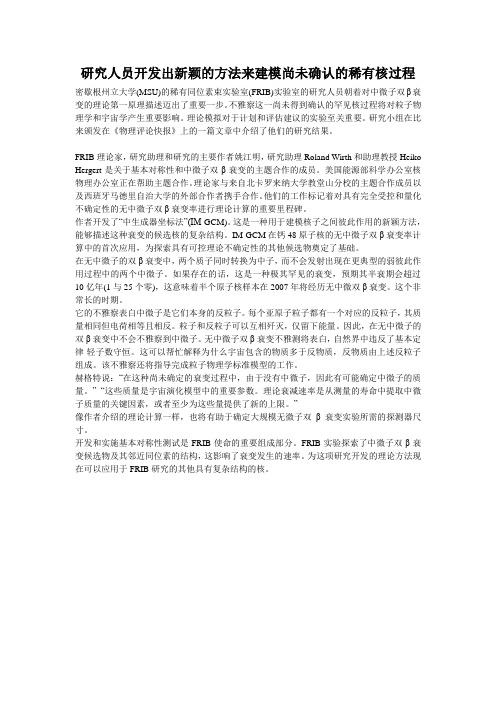
研究人员开发出新颖的方法来建模尚未确认的稀有核过程密歇根州立大学(MSU)的稀有同位素束实验室(FRIB)实验室的研究人员朝着对中微子双β衰变的理论第一原理描述迈出了重要一步。
不雅察这一尚未得到确认的罕见核过程将对粒子物理学和宇宙学产生重要影响。
理论模拟对于计划和评估建议的实验至关重要。
研究小组在比来颁发在《物理评论快报》上的一篇文章中介绍了他们的研究结果。
FRIB理论家,研究助理和研究的主要作者姚江明,研究助理Roland Wirth和助理教授Heiko Hergert是关于基本对称性和中微子双β衰变的主题合作的成员。
美国能源部科学办公室核物理办公室正在帮助主题合作。
理论家与来自北卡罗来纳大学教堂山分校的主题合作成员以及西班牙马德里自治大学的外部合作者携手合作。
他们的工作标记着对具有完全受控和量化不确定性的无中微子双β衰变率进行理论计算的重要里程碑。
作者开发了“中生成器坐标法”(IM-GCM)。
这是一种用于建模核子之间彼此作用的新颖方法,能够描述这种衰变的候选核的复杂结构。
IM-GCM在钙48原子核的无中微子双β衰变率计算中的首次应用,为探索具有可控理论不确定性的其他候选物奠定了基础。
在无中微子的双β衰变中,两个质子同时转换为中子,而不会发射出现在更典型的弱彼此作用过程中的两个中微子。
如果存在的话,这是一种极其罕见的衰变,预期其半衰期会超过10亿年(1与25个零),这意味着半个原子核样本在2007年将经历无中微双β衰变。
这个非常长的时期。
它的不雅察表白中微子是它们本身的反粒子。
每个亚原子粒子都有一个对应的反粒子,其质量相同但电荷相等且相反。
粒子和反粒子可以互相歼灭,仅留下能量。
因此,在无中微子的双β衰变中不会不雅察到中微子。
无中微子双β衰变不雅测将表白,自然界中违反了基本定律-轻子数守恒。
这可以帮忙解释为什么宇宙包含的物质多于反物质,反物质由上述反粒子组成。
该不雅察还将指导完成粒子物理学标准模型的工作。
通过幺正操作传送未知两个三能级粒子纠缠态(英文)
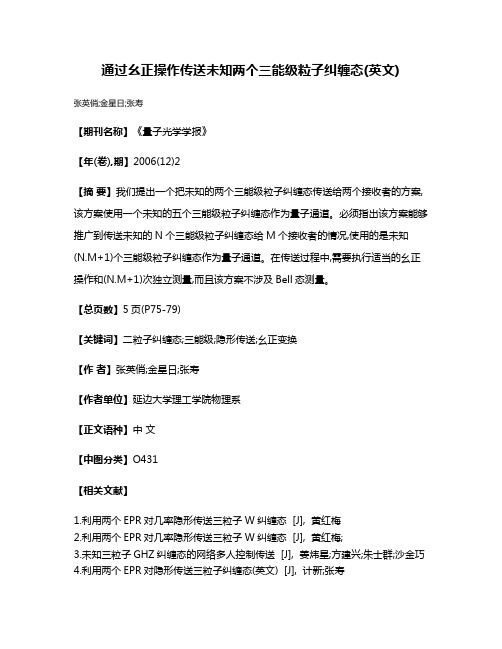
通过幺正操作传送未知两个三能级粒子纠缠态(英文)
张英俏;金星日;张寿
【期刊名称】《量子光学学报》
【年(卷),期】2006(12)2
【摘要】我们提出一个把未知的两个三能级粒子纠缠态传送给两个接收者的方案,该方案使用一个未知的五个三能级粒子纠缠态作为量子通道。
必须指出该方案能够推广到传送未知的N个三能级粒子纠缠态给M个接收者的情况,使用的是未知(N.M+1)个三能级粒子纠缠态作为量子通道。
在传送过程中,需要执行适当的幺正操作和(N.M+1)次独立测量,而且该方案不涉及Bell态测量。
【总页数】5页(P75-79)
【关键词】二粒子纠缠态;三能级;隐形传送;幺正变换
【作者】张英俏;金星日;张寿
【作者单位】延边大学理工学院物理系
【正文语种】中文
【中图分类】O431
【相关文献】
1.利用两个EPR对几率隐形传送三粒子W纠缠态 [J], 黄红梅
2.利用两个EPR对几率隐形传送三粒子W纠缠态 [J], 黄红梅;
3.未知三粒子GHZ纠缠态的网络多人控制传送 [J], 姜炜星;方建兴;朱士群;沙金巧
4.利用两个EPR对隐形传送三粒子纠缠态(英文) [J], 计新;张寿
5.非最大量子纠缠信道的量子态传送——在腔QED系统中利用非最大三粒子纠缠GHZ态传送未知原子态 [J], 杜茜华;陈复;陈子翃;林中晞;林秀敏
因版权原因,仅展示原文概要,查看原文内容请购买。
- 1、下载文档前请自行甄别文档内容的完整性,平台不提供额外的编辑、内容补充、找答案等附加服务。
- 2、"仅部分预览"的文档,不可在线预览部分如存在完整性等问题,可反馈申请退款(可完整预览的文档不适用该条件!)。
- 3、如文档侵犯您的权益,请联系客服反馈,我们会尽快为您处理(人工客服工作时间:9:00-18:30)。
February 1, 2008
Abstract
We construct the vector fields associated to the space-time invariances of relativistic particle theory in flat Euclidean space-time. We show that the vector fields associated to the massive theory give rise to a differential operator realization of the Poincare algebra, while the vector fields associated to the massless theory, including the space-time supersymmetric sector, allow extensions of the conformal algebra in terms of commutators.
1
then dimensionally extended to give rise to the Green-Schwarz superstring [3]. The superstring action can then be further extended to supermembranes [5]. However, while in particle theory the existence of this local fermionic symmetry is a natural consequence of the particle’s own dynamics, in superstring and supermembrane theories additional Wess-Zumino terms must be included in the action for the fermionic symmetry to be present. This procedure of including Wess-Zumino terms is thus quite artificial and so the origin of this fundamental fermionic invariance, as a manifestation of the system’s own dynamics, can be appreciated only in the case of particle theory. This is one of the interests of this work.
1 Introduction
The relativistic particle continues to be one of the most interesting dynamical systems to investigate if one wishes to try to understand aspects of physics at a fundamental level. Among the many reasons for this, we point out that relativistic particle theory has many features that have higher-dimensional analogues in relativistic string theory while, at the same time, is a prototype of general relativity. In the past few time there has been an intense activity in trying to explain a small positive measured value for the cosmological constant [1]. As a consequence of this activity, a number of quite different and interesting analyses of the cosmological constant problem have appeared [2]. In this context, relativistic particle theory may be used as the simplest possible model for the study of the cosmological constant problem because in the “einbein” version the relativistic particle action defines a one-dimensional generally covariant field theory in which the particle’s mass may be viewed as a one-dimensional cosmological constant.
arXiv:hep-th/0403136v1 12 Mar 2004
Relativistic Particles and Commutator Algebras
W. F. Chagas-Filho Departamento de Fisica, Universidade Federal de Sergipe
Another interesting point of particle theory, that attracted very little attention, is the question if there exists a specific dimension for the consistency of the supersymmetric theory. It is well known that quantum superstrings seem to work only in space-time dimension D = 10 while for supermembranes the critical dimension seems to be D = 11. However, no restriction on the spacetime dimension appears to exist in the case of the superparticle. To parallel the treatment of superstrings, superparticle. theories are then usually formulated in D = 10. In this work we study this problem at the classical level only but we are able to give evidence that superparticle theory is a consistent theory only in D = 9.
The paper is divided as follows: In section two we review the concept of space-time vector fields and show how the generators of certain specific vector fields give differential operator realizations of the Poincar´e algebra and of the conformal algebra in D bigger than 2. In section three we construct the vector field associated to the invariances of the massive particle action in flat space-time and find that its generators give a differential operator realization of the Poincar´e algebra. Section four deals with the massless particlead to a differential operator realization of the conformal algebra. In particular, we show that when the condition for free motion is satisfied, a new invariance of the action permits the construction of an extension of the conformal algebra. In section five we show how the features found in bosonic particle theory may be extended to relativistic particles with space-time supersymmetry. We present our conclusions in section six.
We are also interested here, as a way to gain some insight into the cosmological constant problem, in the relationship between the presence of a non-vanishing mass value in the bosonic particle action and the space-time invariances of the action. We study this problem by associating a space-time vector field to each of the space-time invariances of the action and then computing the algebra defined by the generators of these vector fields. The result we find is that the massless particle action has a larger set of space-time invariances and then the appearance of a non-vanishing mass may be associated to the breaking of some of these extra invariances. A positive non-vanishing value for the cosmological constant could then also be the result of symmetry-breaking mechanisms.
